#How and Why Reconstruct a website or Mobile App?
Explore tagged Tumblr posts
Text
This image gives a solid, compact breakdown of what a Next Generation Firewall (NGF) actually does. It’s way more than just blocking ports like the old-school firewalls. These bad boys are the Swiss Army knife of cybersecurity—combining multiple tools into one powerhouse of a system. Here’s a detailed look at each feature shown:
⸻
Core Capabilities of a Next Generation Firewall (NGF):
1. Antivirus
Blocks known malware and viruses at the perimeter.
2. Intrusion Prevention System (IPS)
Detects and prevents malicious traffic using signatures and behavior analysis.
3. Mobile Security
Extends firewall protection to mobile users and endpoints.
4. Threat Intelligence Service
Feeds live data about current threats into the NGF for real-time defense.
5. Antispam
Blocks phishing and spam-based attacks, especially in emails.
6. Vulnerability Management
Identifies and manages security flaws in systems or software.
7. Virus Outbreak Protection Service
Early detection of new virus variants through heuristic analysis and sandboxing.
8. IP Reputation
Blocks or flags traffic from known malicious IPs.
9. Content Disarm & Reconstruction (CDR)
Strips potentially dangerous content from documents and reconstructs safe versions.
10. Industrial Security
Secures SCADA/ICS systems often used in factories and utilities.
11. Cloud Access Security Broker (CASB)
Monitors cloud service use and enforces security policies for SaaS apps.
12. Application Control
Manages and restricts access to applications by user, group, or device.
13. Web Filtering
Blocks access to malicious or inappropriate websites.
14. Security Rating Service
Gives your network or firewall a security score based on current configurations and threats.
15. Web Security
Protects against threats from web browsing like drive-by downloads and malicious scripts.
16. Indicators of Compromise (IoC)
Detects subtle signs that a system may be compromised.
⸻
Why This Matters:
Next-Gen Firewalls don’t just filter traffic—they analyze behavior, apply AI-based detection, and adapt in real-time. Whether you’re working in cybersecurity, IT management, or penetration testing, understanding NGF features helps you:
• Design layered defenses
• Troubleshoot with more context
• Detect threats earlier
• Improve security posture assessments
⸻
Want to go deeper into how NGFs are implemented or maybe compare top vendors like Fortinet, Palo Alto, or Cisco Firepower
0 notes
Link
While introducing an app or website, businessmen expect it to increase their profit. And mostly business owner does it. However, that can change on a daily basis, and many competitive mobile apps and websites coming into the market. Therefore, your design of the app or web becomes outdated but your potential user replaces you with your competitor. So you should need to focus on the changing of competitors and evaluate it then upgrade it.
#How and Why Reconstruct a website or Mobile App?#How and Why Reconstruct a website or Mobile App#How and Why Reconstruct a Mobile App
0 notes
Text
10 Proven Ways to Improve Your Ecommerce Bounce Rate

High bounce rates are costly and indicative of problems with operational processes and business management.
A rising bounce rate shows that potential customers are leaving your product or service page without making a purchase. These are web visitors who enter your site and leave (“bounce”) instead of proceeding to view other pages within the same website.
This exit rate affects your business revenues, but it is essential to understand that all eCommerce outlets, including the most successful global brands, experience bounce.
Companies cannot reduce the bounce rate to zero because there always are customers who are not ready to visit other pages on the same site or make a purchase.
To understand how to control the exit rate, this article will tackle the definition of the term, causes, tools to detect it, and 10 best ways to improve your eCommerce bounce rate.
What is a bounce rate?

Benchmark bounce rates by website type - Image Credit: growcode.com Bounce rate refers to the level of site visitors who leave your eCommerce website immediately after clicking on one page. It is calculated as the proportion of single-page visitors to total visitors, expressed as a percentage. It symbolizes visitors who land on the product page but exit without interacting or taking further action during that session.
Bounce rate (%) = No. of visits accessing only 1 page/ Total no. of website visits
According to HubSpot, the general bounce rates to look out for by sector or industry are 40-60% (content websites), 30-50% (lead generation), 70-98% (blogs), 20-40% (retail sites), 10-30% (service sites), and 70-90% (landing pages). Still, eCommerce websites should aim for a low bounce rate as possible by keeping visitors interested in their content, products, and services, and potentially converting them.
Causes of bounce rates
If you manage an eCommerce website, you want visitors to convert by accessing other webpages on the same site, start buying items on sale, read more content, or fill out a signup form.
However, if there is a bounce, it could signal that the visitor did not find what he or she was looking for or the webpage was too complex to navigate. Other causes of bounce rates include:
A visitor clicking on a website accidentally.
Few relevant pages.
Visitors cannot understand or locate the site navigation.
The site appearance and graphics turn visitors away.
The content (text, images, and video) is unappealing to the visitor.
The web pages load too slowly.
Intrusive popups and ads affecting customer experience.
There is no eCommerce call to action.
Tools to detect bounce rates
<img src="https://www.wishpond.com/wp-content/uploads/sites/3/2020/11/image4-7.png">
Google Analytics will not tell you why visitors are bouncing from your website. You need to gather more data and insights using the following 3 tools:
Heatmaps reflect what site visitors see and interact with. It will help you to improve your eCommerce bounce rate by determining if people are seeing the most essential content on the landing page and how many more pages they click on. This content may include brand messages and product information enticing people to scroll further and engage more.
Heatmaps provide data analysis, giving you a glance at what your site visitors scroll through, click on, or ignore. With this information, you can identify trends and optimize your sites for higher engagement.
The following diagram demonstrates an example of a heatmap, which enables you to see where visitors click when using desktop devices or tap their fingers when using smartphones. The color-coding on the map shows the clicked elements.
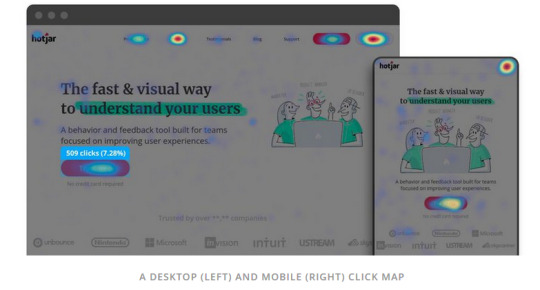
On-site surveys enable you to gather customers’ feedback about their experiences, including their questions, expectations, and frustrations. You can ask questions to gauge the quality of service, things they like about a specific page, and factors they would consider when buying items from the website. For instance, you can ask users if the website feels trustworthy, how they heard about your site, and what they found any troublesome pages in need of fixing.

Session recording, also known as session replays, enables you to review user sessions and observe what people do on the web pages before exiting. You can reconstruct the sessions to understand what visitors experienced during a session. Some insights to derive from session recordings are the possibilities of user confusion or frustration (if page elements are non-clickable), the page sections they seem to miss or linger on most, and what users were doing right before the exit.
Now that you understand all about bounce rates, let’s discuss the top 10 ways to improve it.
1. Improve page loading speeds
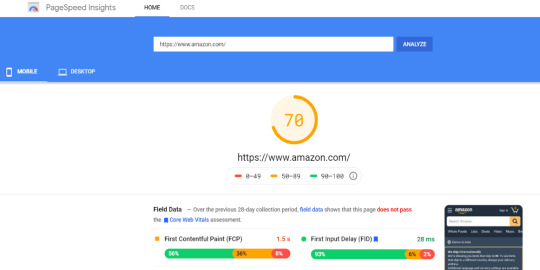
Slow-loading pages can make customers get frustrated and lose interest in your web page. On average, 47% of customers expect your eCommerce web pages to load within 2 seconds or less. According to research by CrazyEgg, a one-second delay in page-load time causes 11% fewer page views, a 16% decline in customer satisfaction, and 7% in lost conversions.
The Sachs Marketing Group suggests that the following factors can contribute to your web page loading slowly:
*Server/hosting - slow speeds can arise if your web hosting company does not have enough resources on their server. This scenario also occurs when you use shared hosting instead of a virtual private server, especially when you operate a large website. *File types and sizes - many, large files and images will slow down your site. *Plugins - running too many plugins on your site or using plugins that are not optimized can slow your site down, *Traffic volume - the amount of data your site can accommodate from visitors can grow smaller as your traffic volume increases, leading to a slower website.
You can still improve your page loading speeds by optimizing your files and plugins and investing in private hosting with the ability to accommodate a high bandwidth as your traffic grows. You can also minimize and combine your files, lower server response time, and adopt more technical measures.
One of the best strategies for improving your eCommerce bounce rate is to ensure you test and analyze your site’s speed. You can do so using tools like Google’s PageSpeed Insights, which scores and compares your site performance on both the desktop and mobile.

Need help marketing your eCommerce store?
Book a free call to learn how our team of eCommerce experts can help you generate leads, boost traffic and drive MORE sales.
2. Attract the right site visitors
You should reduce the bounce rate arising from the wrong traffic by choosing the right keywords for your content. The goal should be to attract qualified visits, not just the most number of views. You can also develop multiple landing pages with unique keywords and content to suit the needs of different buyer personas.
To optimize your web page for the right visitors, ensure to use meta descriptions to guide search engine users. Meta descriptions are short-form descriptions of a given page or article appearing under the title section of search results.
It influences whether users or Google or other search engines click on your website link or not. It is one of the best ways to improve the eCommerce bounce rate because it directs the right traffic while keeping away the rest.
A good meta description should contain less than 160 characters (120 characters for mobile devices), should contain the page’s primary keyword or keyword phrase, and should use a complete and compelling sentence(s).
In addition to writing attractive, useful, and short meta descriptions, you should also ensure your online advertising campaigns target the right audience for an improved bounce rate.
You should perform research to select the appropriate keywords to match your content, create many landing pages with unique keywords and content according to your buyer personas, and target your audience using social media shares and other relevant tactics.

3. Fix technical issues
Finding and fixing site usability issues is one of the best ways to improve your eCommerce bounce rate levels. If visitors cannot navigate or click on items within your web pages, you can expect a high bounce rate.
The main usability issues include:
Websites that don’t respond well on specific browsers or mobile
Technical errors like error 404
Broken links and faulty drop-down menus

The best way to detect these issues is to conduct usability testing using eye-tracking equipment or by watching session recordings of how people interact with your app or website.
For instance, you can watch session recordings of users’ navigation journey. During this process, you can review your high-bounce pages and note down problems visitors are likely to run into. You should then fix the issues promptly.
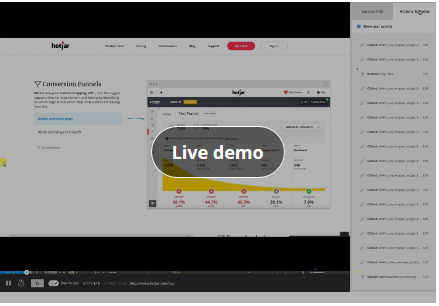
You can also test your pages manually to check if they have any loading problems, links not working, or errors both on the desktop or mobile. Errors are commonplace whenever you introduce changes to your site, making it essential to test your pages whenever you upload new products and content.
You can fix these issues by removing any broken links manually and replace them with functional or correct ones. You can also optimize and update your plugins to ensure they are compatible with your website themes. If unable to fix more technical errors, ensure to engage your site developer for support.
4. Publish quality, trustworthy content
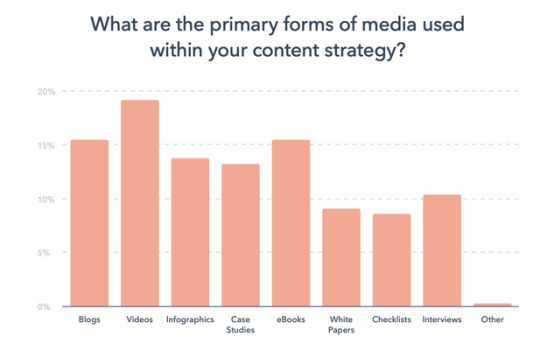
Ensure your website has attractive and customer-friendly images and videos. 84% of web visitors have reported that at one point they were convinced to buy an online retailer’s product or service because they watched a video of the brand. You should also invest in quality content.
Keep the following points in mind to keep site visitors engaged and lower the bounce rate:
Have a relevant main message and titles
Use clear headings and subheadings
Use stylish images and colors
Proof-read your content for grammatical errors
Insert a clear call-to-action and links directing customers on the next steps
A look at the Uber website will show you how the brand leverages quality content to keep visitors scrolling and visiting other pages. The “About US” page, for instance, has the following elements:
A relevant title - “We ignite opportunity by setting the world in motion.”
Clear headings - “Rides and beyond,” “Your safety drives us,” “Company info,” and “Keep up with the latest,” among others. There are plenty of clear subheadings too.
A call-to-action - There is a “Sign Up” button at the top-right corner of the site.
Flawless English.
Stylish images - see below

You should also ensure your site looks trustworthy to build the confidence of prospective customers. Many first-time visitors will not buy from an unsecured website, further affecting the bounce rate.
The following steps can help you to improve your site’s trustworthiness:
Reduce or remove the number of content-blocking popups on the page. Irrelevant and invaluable popups can frustrate or overwhelm visitors.
Add user reviews and testimonials. First-time visitors will be convinced to look at other pages on your website or even buy your offering if they can see social proof.
Continuously monitor site performance using recordings and heatmaps to evaluate the impact of any changes you make and improve them promptly.
5. Employ upselling & cross-selling tactics

Upselling and cross-selling are among the best ways to improve your eCommerce bounce rate effectively. Upselling is encouraging shoppers to buy a more expensive version of an existing product or service, such as a premium or upgraded package for a software.
On the other hand, cross-selling entails suggesting related, additional, or complementary goods, such as offering customers to purchase ink with a printer.
According to HubSpot, you should employ the following upselling tactics to improve your eCommerce bounce rate:
Understand what customers value or want to determine the best products and services to meet their needs.
Identify and focus your upselling campaigns on customers who clearly have gaps you can close in their current packages or plans.
Start providing the target customers with real returns, value, or benefits as soon as possible to demonstrate your expertise and deepen the relationship.
Provide customers with transparent pricing information, including a breakdown of the timing and costs involved.
Incorporate trends into the sales plan to proactively discover opportunities to upsell.
To implement upselling strategies successfully, you should invest in the right products, have superior knowledge of your products, display/place your products strategically, provide maximum value, and listen to your customers’ needs actively.
The best places to place your upsells are at the checkout page or after customers add items to the cart, product pages (enables you to show off multiple product versions), and when your customers reach a given success milestone.
Pro Flowers incorporates upselling strategies at the checkout page.

Amazon upsells by displaying and recommending other frequently bought products

When you upsell and cross-sell, you encourage customers to continue interacting with your web page, lowering the bounce rate while improving conversions. Amazon uses this approach, whereby customers visiting the “camera & photo category,” for instance, can also view the Prime Day deals and discounted items. The retailer uses the approach to incentivize customers to stay on the page for long by helping them identify other products and services they might need.
6. Make the website responsive and mobile-friendly

You should optimize your website and its contents for multiple devices, including desktop and mobile.
Statistics by TechJury show that consumers spend more than 69% of their media time on their mobile phones. As of 2019, smartphones accounted for 52% of all web internet traffic globally.
The average bounce rate arising from the use of mobile phones is 60%, compared with about 42% for the desktop.
To leverage the best conversions and improve your eCommerce bounce rate for phone users, ensure your site has a simple WordPress theme, and install the right plugins. This step will ensure your pages are updated often and responsive on the backend.
You can check if your site is mobile friendly using a mobile-friendly test tool from Google. Once you plugin your site URL, you should click on the “ANALYZE” button. WordPress users can use the JetPack plugin or WPTouch plugin.
Other measures to take to make your site mobile-friendly include:
Add a responsive eCommerce theme
Simplify the product menus
Display your calls-to-action clearly
Make the help center easily accessible
Add a search function
When your site is optimized, you capture more smartphone users while improving your eCommerce bounce rate.
7. Invest in intuitive navigation

Sometimes users cannot figure out how to navigate the website or how to get to where they want to go. One of the best ways to improve your eCommerce bounce rate is to ensure the navigation elements are clear and intuitive.
Customers should not have to guess where the call to action is, neither, should they have difficulties understanding your site’s navigation structure. You should simplify the navigation tabs to make it seamless for site visitors to explore other pages or take a specific action.
For instance, you can install a visible and honest call to action to avoid creating the impression of an insecure website. You can also develop a table of contents to make it easy for web visitors to select the specific sections they would like to visit on your page. eCommerce sites reduce user confusion and frustration by creating categories for the main types of products they sell.
8. Target engaged visitors

Sometimes if you’re running a resource section or blog post, you’ll get many users who will leave your page the moment they find what they want. If you are looking to convert these visitors, you should show them the most relevant offers while they are still navigating your website.
If for instance, a visitor is viewing content on influencer marketing, you should display offers on tools to leverage influencer marketing instead of household items. This strategy can help improve your eCommerce bounce rate while increasing the conversion rate.
Tools like heatmaps will enable you to study, analyze, and understand customer behavior, informing you of the pages customers are paying the most attention to.
You can create promotions or upsell and cross-sell your product features and other benefits on these pages. The goal is to emphasize the additional value your already engaged customers can gain from your offering.
Heatmaps will also inform you if customers are hesitant to click on certain pages due to the appearance of ads or popups. You can then remove or place the distractors in a more strategic place to keep your site visitors engaged.
Storytelling is also a good way to connect with your customers, drive mutual relationships, and keep already engaged visitors on your site.
When creating stories, ensure to talk about people, not your services or products, evoke emotions, be honest, and focus on what customers expect to gain from buying or using your products.
9. Insert strategic and helpful internal links

When you insert relevant internal links in your content, you increase a site visitor’s engagement. They will be led to other pages within your website, increasing their interest in your products and services and the conversion rate.
In the event they landed on the wrong page, strategic internal links can enable visitors to reach the intended page or category while keeping them browning instead of leaving.
When linking your pages, ensure they are relevant, they have a relationship with each other, and have value-generating characteristics or benefits to site visitors. For instance, you should link related child pages to parent pages and vice versa.
A parent page can be the Product category, while the child page can be the specific products you are selling, such as electronics, household equipment, and others.
You can insert links suggesting content and products using tools like Yoast for SEO, Link Whisper, and Interlinks Manager.
This tactic will make your content easy to find. See the below example where you can link the content for Lion, Leopard, and Cheetah to each other. The page for Africa’s big cats can also be linked to the one for Asia’s big cats, both of which fall under the Big Cats parent category.

10. Engage abandoning visitors
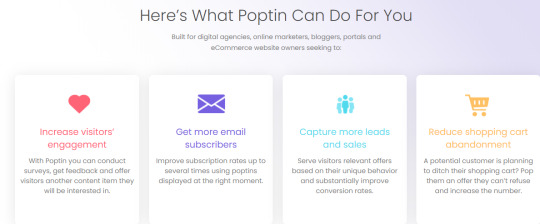
Irrespective of what you do to improve your eCommerce bounce rate, there are still users who will leave your website after clicking only one page. Some of them may have clicked your site in error or just had an emergency and had no option but to leave abruptly.
How can you track users when they are about to leave your site and convert them into subscribers?
One of the most powerful tools to use the Poptin tool, which enables you to display a popup message when users abandon their shopping carts.
It enables you to send customized offers, improving both conversions and bounce rates. You can also display subscription messages when site visitors visit or when about to leave your website.
You can also display a pop-up with a last-minute discount, which users can choose to go for or simply close the window. When you combine an exit offer with a subscription form, you run a high chance of controlling your eCommerce bounce rate.
When displaying popups, ensure to:
Use the right format (insert those that move in from the sides),
Serve them in a timely manner (like when visitors are about to leave the page),
Integrate them with your website (using branding elements like your company logo), and
Create a clear path by prompting action and grabbing the site visitor’s attention.
However, you should not use popups with an aggressive call-to-action tone like Yes/No and avoid asking for too many things in one popup. For instance, you can ask users to sign up for your services or ask them for their email address only. Also, avoid too bulky popups (keep it simple).
Conclusion
Bounce rate is measured using the number of site visitors who leave after clicking on only one page.
Although it is not practical to lower the bounce rate to zero, you should aim to keep it to the minimum. Tools like heatmaps, on-site surveys, and session recordings can help you to determine the bounce rates.
Once you identify the reasons visitors are leaving, you can improve your eCommerce bounce rate by adopting relevant strategies like enhancing the page speed, fixing technical issues, making the mobile eCommerce, and targeting engaged and abandoning users, among others. Depending on your business type, these tactics will lower your bounce rate significantly.
You can improve your site speeds by optimizing your files and plugins, and investing in private hosting. You should also attract the right visitors to your site using meta descriptions of your content titles. Your content and images should also be appealing to your users.
Consider using the recommended upselling and cross-selling strategies to make your campaigns value generating. Technical-related fixes like addressing site usability issues, ensuring your site are responsive, and employing intuitive navigation will improve your engagement with customers.
Overall, you should target both engaged and abandoning visitors by inserting strategic internal links on your eCommerce site.
About the Author

Rithesh Raghavan is the co-founder of Acowebs, an online store for eCommerce plugins with 15000+ satisfied customers across the globe. Having rich experience of 15+ years in Digital Marketing, Rithesh loves to write up his thoughts on the latest trends and developments in the world of IT and software development.
from RSSMix.com Mix ID 8230801 https://ift.tt/3mu8tuf via IFTTT
0 notes
Text
Smithsonian Scientists Need Ginkgo Leaves to Study Climate Change—They Need Your Help
https://sciencespies.com/nature/smithsonian-scientists-need-ginkgo-leaves-to-study-climate-change-they-need-your-help/
Smithsonian Scientists Need Ginkgo Leaves to Study Climate Change—They Need Your Help

SMITHSONIAN.COM | Aug. 6, 2019, 10:38 a.m.
The next time you venture into the great outdoors, keep an eye out for Ginkgo biloba trees, which can be easily identified by their distinctive fan-shaped leaves. If you find one—and you likely will, as the native Chinese plant is now ubiquitious in the United States—take a moment to pluck a few leaves, snap some photographs of the scene, and record your observations via the iNaturalist mobile app. Then, package your sample in an envelope, drop it into the mailbox, and give yourself a pat on the back. Congratulations: You’ve just become a citizen scientist, helping researchers at the Smithsonian’s National Museum of Natural History use ginkgo leaves to study the past, present and future of climate change.
Perhaps best known for its pungent smell and medicinal properties, ginkgo actually boasts an impressive backstory. As the online portal for the museum’s Fossil Atmospheres project explains, the conifer plant (meaning it has seeds but doesn’t produce flowers) arrived on the scene more than 200 million years ago. Surviving three mass extinctions, including the one that killed the dinosaurs, ginkgo has retained a remarkably similar appearance throughout its time on Earth. This characteristic makes it possible for scientists to easily compare modern specimens with fossils dating to the distant past—a practice that could help researchers assess how the planet’s atmosphere has changed over time, as well as predict what effect future climate shifts will have on Earth’s living creatures.
Rich Barclay, the paleobotanist who leads Fossil Atmospheres, says the project consists of two main parts: an experiment based out of the Smithsonian Environmental Research Center in Edgewater, Maryland, and a multi-phase citizen science initiative. Per a Smithsonian Voices blog post penned by Barclay and Laura Soul, the museum’s Deep Time Science Education Specialist, in June 2017, the experimental side of the research revolves around a grove of 10-foot-tall ginkgo trees being grown at carbon dioxide concentrations ranging from 400 parts per million (ppm), or the level found in the atmosphere today, to 1,000 ppm, a ratio last seen when Earth’s climate was so warm that there were no polar ice caps.




Grove of ginkgo trees being grown at carbon dioxide concentrations that range from 400 ppm to 1,000 ppm.
(Rich Barclay)
The citizen science component, on the other hand, began with crowdsourced stomatal counting—a plant’s stomatal index reflects carbon dioxide concentration at the time of its growth, enabling scientists to gauge the conditions in which a specimen developed—and is set to continue with a newly launched leaf survey. This latest phase, running for the entire month of August, asks science enthusiasts from across the country to send in ginkgo leaves from their local communities. These samples will be used to paint a clearer picture of how a plant’s features reflect the environment in which it grows, providing insights on contemporary climate that can then be applied to prehistoric climates, as represented by well-preserved ginkgo fossils.
Soul, who leads the educational side of Fossil Atmospheres, explains, “We can’t go out and get leaves from every state in North America, but the public can. . . and that’s why citizen science performs [such] a vital role in what we’re doing.”
She adds, “[Citizen scientists] are enabling the project to have a much broader scope and [helping researchers] answer questions that we wouldn’t be able to answer otherwise.”
To contribute, interested parties must follow a detailed set of instructions outlining the process of obtaining, recording and submitting specimens. Be sure to follow every step, from identifying the sex of a chosen ginkgo tree to noting its exact location, uploading photos and observations to the iNaturalist app, and properly packaging the leaves, or else the scientists will not be able to use your sample. For more details, visit the project’s website or email [email protected].
Attention nature-lovers, the @smithsonian needs your help in a #CitizenScience project! Gather leaves from Ginkgo trees, mail them to our @FossilAt research team, and advance our understanding of Earth’s climate history! #FossilFriday https://t.co/5Ay7g58hUu pic.twitter.com/oePfpC1vQk
— Smithsonian’s NMNH (@NMNH) August 2, 2019
By restricting the time period in which samples are collected, as well as outlining specific instructions, Barclay says the team will be able to reduce the number of variables affecting stomatal count down to geographic range and environmental factors such as temperature, rainfall, elevation and latitude. Ultimately, data garnered from these public contributions will play a key role in published scientific research. Even if specimens aren’t used for Fossil Atmospheres specifically, Soul points out that they will be permanently accessioned into the Smithsonian’s collections: She notes, “Future scientists will be able to use them to answer questions that we haven’t even thought of yet.”
The exact science behind the project largely comes down to stomatal index, which serves as a climate proxy, or means of reconstruction, for past carbon dioxide concentration. In layman’s terms, stomata are tiny openings on leaves’ surfaces that let in CO2 but expel oxygen and water. Stomatal index refers to the optimal number of stomatal pores needed to facilitate this exchange and is determined by an array of environmental factors, chief among them the level of carbon dioxide in the atmosphere.
As Barclay explains, low stomatal numbers tend to correspond with high CO2, while high stomatal numbers correlate with low CO2. But while researchers “know there’s a strong relationship between decreasing number of pores. . . and increasing CO2,” previous studies have failed to fully quantify this dynamic.
“We knew we needed to redo [the research], and we wanted to do it in a more realistic way,” the paleobotanist says. “We moved to this scenario where we’re actually growing trees under elevated conditions, . . . pushing the plants to higher CO2 concentrations than [have] ever been studied.”




A plant’s stomatal index reflects carbon dioxide concentration at the time of its growth, enabling scientists to gauge the conditions in which a specimen developed.
(Rich Barclay)
According to Barclay, Fossil Atmospheres is unique in both its scale and level of citizen science involvement. In addition to the leaf survey, the volunteer side of the project involves counting stomatal pores captured in images of modern and fossilized leaves. This task is decidedly more difficult than simply collecting and cataloguing leaves, but the campaign’s Zooniverse page offers tips, tutorials and practice rounds for those willing to give it a try. (For what it’s worth, more than 3,300 participants have contributed 31,000 classifications to date.) Samples collected via the leaf survey will later be imaged and added to the counting page.
“Some people are excellent at [counting], and some people struggle a bit more,” Soul observes. Since each image is presented to multiple volunteers, however, the team has found that maximizing participation usually yields an accurate answer.
In Barclay’s view, citizen science benefits everyone involved. Volunteers have an opportunity to contribute valuable scientific research and learn more about the topic at hand, while experts gain a trove of usable data. With more individuals collecting leaves and counting stomatal pores, the project can be completed in a reasonable amount of time—namely, within the next several years.
Fossil Atmospheres’ ultimate goal is to determine the relationship between carbon dioxide and stomatal index. By doing so, Barclay and Soul write in Smithsonian Voices, “We should be able to pick up a fossil ginkgo leaf and know the composition of the air in which it grew.” At the same time, the researchers hope to use their findings to answer a key question about the future: “As we humans add carbon dioxide to the atmosphere, how warm will the planet get?” The answer, according to the pair, lies in the past, locked in the minute nooks and crannies of ginkgo leaves’ surfaces.
“The real benefit [for volunteers] is to participate in a project that’s actually answering useful questions about our changing climate, which is one of the most pressing issues that we’re facing at the moment,” Soul concludes. “This kind of research. . . is going to be vital moving forward.”




The project, “Fossil Atmospheres,” is unique in both its scale and level of citizen science involvement.
(Rich Barclay)




Modern ginkgo leaves closely resemble fossilized specimens.
(Scott Wing)




Citizen scientists can spot ginkgo leaves based on their distinctive fan-shaped appearance.
(Rich Barclay)
#Nature
0 notes
Text
Behind the Marketing Scenes of Top Web App Design Company: Monterail
Technology alone is not enough to succeed, every product needs a team of passionate people who will give it their best. Monterail
And what is the best for Monterail, the awarded web app design company? By now it meant:
Achieving a 400%+ revenue growth in 2013-2016 and being featured in 2018 Financial Times 1000 Europe's Fastest Growing Companies.

Achieving a 206% revenue growth in 2014-2017, featuring for the second time in a row in FT1000.

A marketing campaign that brought them EUR 750k worth contracts.
New business that accounted for 46% of all 2018 revenue
Worth investigating all of this, right?
So let there be marketing! The content strategy, the social media efforts, the community involvement.
We’ve analyzed everything. Follow us along to learn more about their strategy and “steal” their successful tactics and strategies to implement in your company.
TABLE OF CONTENT
Monterail Web App Design Company- Short Overview
Monterail’s Marketing Strategies Reverse Engineered
Brand Awareness at Monterail
Monterail’s Website and Conversion Rate Optimization
Monterail’s Traffic Acquisition
Content Marketing
Monterail’s Social Presence
Employer branding and hiring
Wrap Up
More than 90% of potential clients who visit the Monterail office decide to work with them.
Kudos to you, guys!
Now, let’s see what makes Monterail such a magnet for clients.
Monterail Web App Design Company - Short Overview
Szymon Boniecki and Bartosz Rega, co-founders of Monterail, were recognized in 2017 New Europe 100 list as changemakers in emerging Europe and as individuals who are improving people's lives with ideas that scale up in the digital world.
But let’s see what other stakeholders have to say about this Wroclaw-based web app design company: their own clients.
Exceeding expectations and overcoming challenges
Proactive, responsive, transparent & flexible
Solution-oriented
Top notch communication
Well organized and professional

Speaking of clients, new business accounted for 46% of all 2018 revenue, compared to 28% in 2017.
What are the secrets behind the success of this web app design company?
We’ll try to follow in their footsteps and reconstruct their employer branding and marketing strategies.
So, let me tell you a story about:
How inbound marketing combined with efficient promotion can get you mainstream
How a team-centered company is of utmost importance
How you can establish leadership through community engagement
Monterail’s Marketing Strategies Reverse Engineered
With Deloitte and Financial Times nominations, 100+ projects covering IoT, web, mobile, Node.js, Ruby on Rails and Vue.js development, Monterail is writing history in Wroclaw IT outsourcing.
Content strategy, offline events, marketing automation, these are just a few of the stories we’ll tell you next, stories that led to the inspirational growth of Monterail.
Brand Awareness at Monterail
As Marty Neumeier says it in his book “Zag”, a brand is not:
A logo
A corporate identity
A product
A brand is “a person’s gut feeling about a product, service or organization”.

How can you influence one’s gut feeling?
Through a lot of social proof.
For software houses for example, the reviews on Clutch, Google, Facebook or Goodfirms are of utter importance.
Awards are also essential if they are done by trustworthy companies.
Monterail’s Awards
Monterail features in Deloitte’s Technology Fast 50 in Central Europe in 2017.
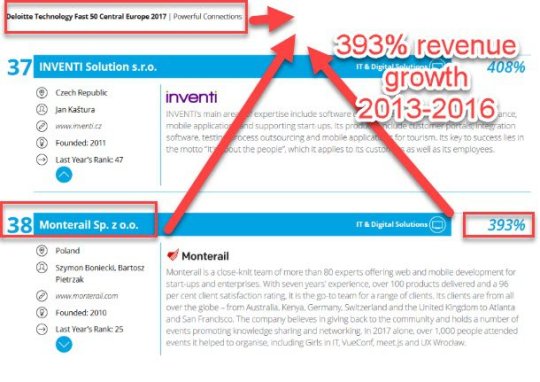
Monterail, as you’ve probably guessed, they’re into Ruby on Rails. Clutch ranked them second in their world Top 15 Ruby on Rails Development Agencies.

The company also ranks 10 in Top 15 Web Developers in Poland - by Clutch.

Monterail’s Website and Conversion Rate Optimization
The website is plain and simple, no mystery there. But beauty lies in simplicity.
It’s easy to find an answer to the buyer persona’s most important questions:
What do you do?
We design and develop web & mobile apps to support startups and businesses on their missions.
How can I trust you?
Case studies, testimonials, client listing.



How can I contact you?
Through a contact form or via chat bot.

They have a projects section where they showcase products and services they’ve designed.
They want to make it clear what the workflow is, they can begin from scratch, with an MVP or scale existing products.

What I like about them is that they have two types of newsletters, focusing either on business, either on technology. This means that personalization is essential in business.

Speaking of personalization, the Hubspot chat bot is used to better qualify the leads and offer a customized experience:

The conversion rate optimization efforts are supported also with automation. It's all about improving the processes and being customer-centric for Monterail. So, Hubspot is their weapon of choice for marketing and sales automation.

CRM, chat bot, forms, CTAs, pillar pages, workflows, CRM - Monterail tried to take the most out of Hubspot when designing the Vue.js campaigns.
Monterail’s Traffic Acquisition
The main website traffic sources, according to Semrush, are:
Direct - 15%
Referral - 1%
Search - 71%
Social - 13%

Social brings more than 10% of the traffic. From our research, this is one of the biggest percentages encountered so far, so we’ll try to understand what strategies lay behind this number.
The 15% direct traffic makes sense because of two main reasons:
Monterail has a team of 6 involved in business development, meaning that they do email outreach, networking

Monterail organizes a lot of events: Monterail Academy, meetups and workshops, but also have a lot of speaking gigs at all sort of tech conferences
30k+ search traffic, give or take, is a considerable amount of search traffic. This is why we’ll dive more into the content strategy to see the strategies behind it.
Content Marketing
The blog is updated kinda bi-weekly. The main tags are agile, culture, project management, Vue.js, product design, Javascript, development, business, mobile development, ruby/rails.
The more technical posts are written by the developers, and these are the posts that bring more traction.
An example is Zuzanna Kusznir, from the back-end team, that wrote a blog post ending up generating 8.4% of the blog’s traffic in 2018.
According to Spyfu, there are 65 keywords showing up on the first page, and 61 are almost there. Thumbs up, guys!

This next screenshot is telling an interesting story:

The technology related keywords are really valuable, bringing in traffic, but the “outsource” cluster is trying to make its way up to the first page.
Non-branded keywords bring traffic to blog post pages. Branded “monterail” traffic, leading to their homepage, is almost insignificant.

Now, I’m gonna peek a bit at their high ranking blog posts.
The most traction was brought by a blog post that covers becoming a certified tester, it’s almost 2 years old, but still bringing in fresh traffic.

They’ve got content also on Slideshare, like this great piece on Storytelling in data visualization, written by Paweł Hawrylak, the Head of Design.
Their account also features a story about Marketing B2B, that accrued 1300 views.

But in content marketing, not everything revolves around blogging.
Besides, blog posts are merely addressing their personas in the awareness stage. The same with the newsletter.
When moving down the funnel we encounter other types of content, such as case studies, which can be leveraged for the consideration phase of the buyer’s journey.

The Vue.js campaign
So, we’re finally here, the campaign that brought Monterail clients worth EUR 750k+
Monterail has a thing for Vue.js.
An untapped framework potential, not enough buzz around it: why not take the lead and be the Vue.js go-to company? So, challenge accepted.
It was 2017.
Was it risky? Hell, yeah. No benchmarks, no assurance that the marketing budget won’t be thrown out the window.
As Monterail rolled up its sleeves it began developing content:
Blog posts
State of Vue.js report
Newsletter
Pillar pages and landing pages
Additional elements on the website
At the core of all this content lays the all-mighty survey:
A four-week period in August and September of 2017
1,126 responses, mainly from software developers and CTOs of organizations using Vue
Responses from 88 countries
+ Lots of promotion and outreach:
Vue conference

Sales activities
Drip email campaign
PR and sponsors
Paid ads: Google and Facebook ads
Social media channels
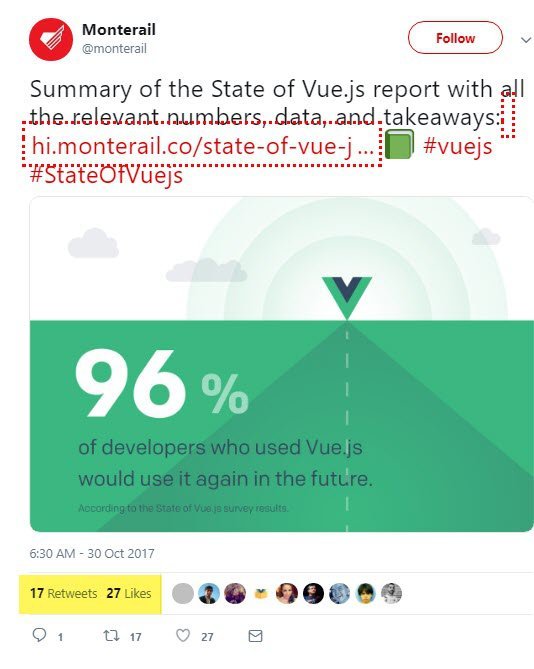
Medium & Quora

Vue.js official channels + influencer Evan You (the creator of Vue.js himself!)

The tools:
Hubspot: forms, CTAs, workflows, CRM
Ahrefs: SEO
Google Analytics
The results:
Valuable backlinks
4500+ downloads of the report in 3 months
300+ Vue conference attendees
10k+ visits ro Vue related content
EUR 10k+ cost (time and ad spend) by Jan 2018
Contracts worth EUR 750k+

Vue.js goes mainstream
The campaign’s key takeaways:
Original content is paramount
Content production and content promotion are equally important
Plan everything
Have goals, KPIs, proper measurement
Consistency in messages across channels, consistency in time
Educate your potential clients
Invest in tools and people. 0 budget, no can do
Be patient and don’t give up, SEO takes time to show results
Know your persona and buyer’s journey
Get influencers on-board
Prioritize your channels, you don’t have to be everywhere
Data manipulation - the right people for the job if you want accurate info
Next: State of Vue.js revisited.

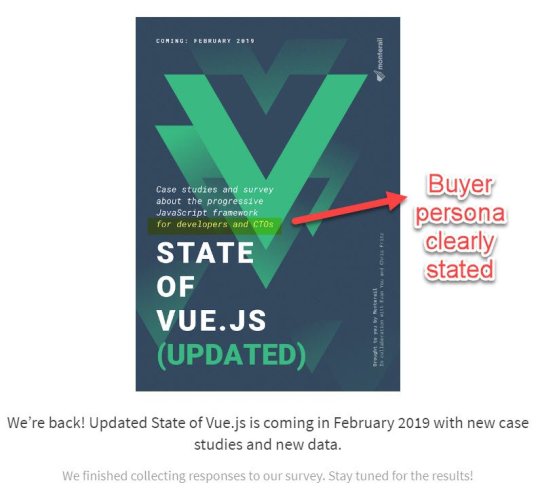
Monterail ran a survey with the purpose of creating the new state of Vue.js report. After having collected the responses and prepared case studies, the updated 2019 State of Vue.js report is out. I’m really curious how the 2019 inbound B2B campaign will turn out. We’ll be watching you guys!
So, Monterail managed to take something relatively unknown and make it mainstream - the Vue.js framework, all through inbound marketing and quality promotion.
They’ve reached their objective of being recognized as the experts in the field.
Chapeau!
This was a great inbound marketing lesson.
Backlinks to Support Content Marketing
Do-follow links from 70+ domain ranking websites link back mostly to the Monterail homepage, and Mozilla is the main attraction.

Backlinks
Putting the pieces all-together, from high search traffic to a solid blog, high-quality backlinks, it’s clear that inbound is at the core of their marketing strategy.
Looking back at the 2018 performance in terms of blog traffic, in comparison to 2017, according to their blog post, the numbers are:
6% more users and 63% more sessions on the website
110% more sessions on the blog itself.
Monterail’s Paid Traffic Acquisition
Monterail is also leveraging Google Ads. From Spyfu’s research, it seems that they are bidding on node.js and vue.js keywords.

We know that they used the power of retargeting during the Vue.js campaign also. And it's not only Google ads remarketing, but also Facebook and Twitter.

But they also use the power of sponsored post for topics such as:
Node.js development
Nearshoring/outsourcing
Successful case studies
Progressive web apps

Monterail’s Social Presence
2500+ Facebook followers
1300+ Twitter followers
1200+ Linkedin followers
Not all of the organic and paid efforts in social media are responsible for these numbers.

All of the other offline or inbound efforts might translate into followers and likes.
Everything connects, and the end result is branding.
Monterail’s Facebook Page
2500+ Facebook followers get regular updates from Monterail regarding events they’re hosting, webinars they’re organizing, jobs available, blog posts and case studies. Vue.js posts seem to be very appealing to Monterail, lately.
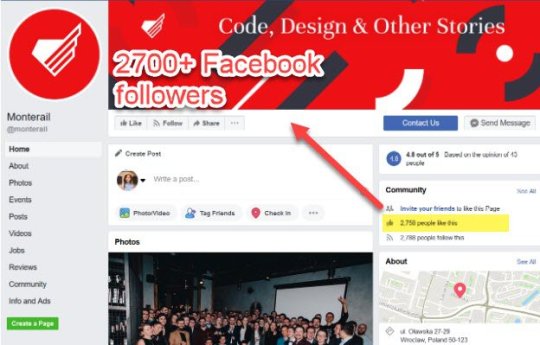
Facebook’s posts are headed two ways:
Getting more clients
Increasing employer branding
Most popular posts talk about the team or Monterail’s events. And check this out, Discovery featured Monterail in a series on entrepreneurship. Kinda cool, I’d say!

Some of the posts get traction, but the average engagement per post is around 14.

Instagram
The Instagram account is all about the team, reinforcing the Monterail idea that “every product needs a team of passionate people who will give it their best.”
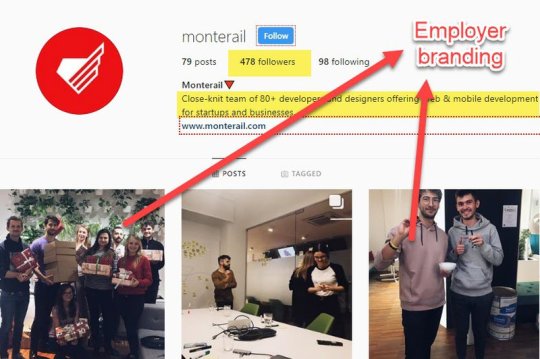
The images are praising a company culture:
that revolves around communication


which happens in a cozy ambiance

where work and play are equally appreciated


Linkedin
On LinkedIn profile news from the industry and blog posts are shared. It’s clearly client-oriented content.

The image being portrayed on LinkedIn speaks of Vue.js leadership, React expertise, products they’ve built.

The platform is also used for hiring because jobs are being posted.

Twitter
Monterail almost replicates the Facebook content within its weekly tweets.
Blog posts and news from the industry are being shared.
They also promote webinars and events they attend to in order to build awareness around their business.
The purpose of the account is more about gaining new clients, than building employer branding.
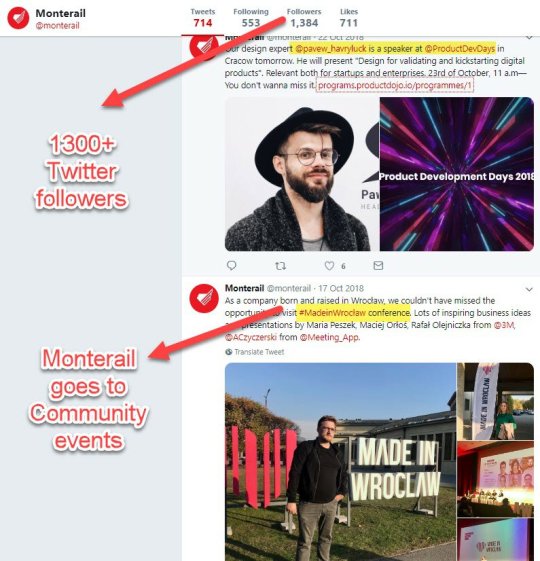
Dribbble
The 290 Dribbble followers get updates from Monterail regarding
Latest web-designs
Apps made by Monterail
Design for events


Most of the shots are published by the Monterail Head of Design, Paweł Hawrylak.
Monterail’s Community Involvement
Webinars, tech summits, meetups, the Monterail Academy - these guys are really busy. But this is how you build a community, establish leadership in the field, for both future employees and clients.

And let’s not forget they’ve hosted a conference around Vue.js with 300+ attendees.
Employer Branding and Hiring
Now, let's mingle with Monterail’s current and former employees and see what they say about the working environment. It seems that the company’s culture and remote working possibilities are highly appreciated.
The quality of code and the learning process are among the pros of working at Monterail. Some say that the management team is a bit un-experienced and decision making takes kinda long.

They want to expand their team by hiring developers and product designers. Salaries and other perks are transparent. There’s also an employee testimonial on the page to increase the chances for conversion.


They are really proud of their office and the friendly atmosphere. They make use of social media to promote the cozy environment. Speaking of the office, it’s not like any other offices. There was a whole strategy around it in the design phase.
Monterail commissioned sociologist Karolina Dudek for an in-depth study of the spatial and cultural needs of the staff. From her observations, they decided to set up rooms for projects, instead of having an open space. So, using science to design the proper working environment, kinda cool, right?
They support learning among the team, that’s why they introduced Self Development Time, meaning every employee has 2 hours per week to spend on whatever they like for personal development.
Wrap Up
From the B2B marketing point of view, it seems that a consistent content strategy, seasoned with some events and marketing automation, is the recipe of success for Monterail.
But let’s make a more comprehensive list of takeaways:
Build an effective team - of engineers, of marketers, of business developers, don’t settle for less
Inbound at the heart of marketing efforts. Get the developers team involved in creating original 10x content
Promotion is key, it should be consistent and carefully planned
Get out there, get noticed, host events, go to speaking gigs, create buzz around you
Plenty of marketing lessons from Monterail, right?
But we ain’t stopping here.
We’ve got more companies up our sleeves.
And, more so, our Ultimate Guide To IT Outsourcing Companies in Central Eastern Europe. will give you a birds-eye view on the IT outsourcing landscape within three ex-soviet countries: Poland, Ukraine and Romania. They’re fast, they’re furious and they’re reshaping the industry.
if(window.strchfSettings === undefined) window.strchfSettings = {}; window.strchfSettings.stats = {url: "https://man-digital.storychief.io/web-app-design?id=256846048&type=12",title: "Behind the Marketing Scenes of Top Web App Design Company: Monterail",id: "4f08255c-5e51-436c-99aa-71482a308009"}; (function(d, s, id) { var js, sjs = d.getElementsByTagName(s)[0]; if (d.getElementById(id)) {window.strchf.update(); return;} js = d.createElement(s); js.id = id; js.src = "https://d37oebn0w9ir6a.cloudfront.net/scripts/v0/strchf.js"; js.async = true; sjs.parentNode.insertBefore(js, sjs); }(document, 'script', 'storychief-jssdk')) from Digital Marketing Automation Consulting | MAN Digital https://mandigitalblog.blogspot.com/2019/04/behind-marketing-scenes-of-top-web-app.html via https://mandigitalblog.blogspot.com/ Read more on our blog MAN Digital MAN Digital Blogger
0 notes
Link
From manual coding to automation and from repeated work to innovation, developer tools have been evolving along with technologies. Alibaba Group and Alibaba Cloud have made its technologies available to public through open source release and cloud-based implementation. These technologies have been accumulated through years of development in various business scenarios. This article introduces some Alibaba developer tools in the hopes that they can help make your development process more efficient and graceful.
Given the vast diversity of technological branches that developers may engage in, this article introduces some tools that may be helpful for backend developers.
1. Arthas Java Online Diagnostic Tool
Arthas is an online diagnostic tool for Java applications open-sourced by Alibaba in September 2018.
Typical scenarios:
You do not know the specific JAR package from which a class was loaded. You want to figure out why your system throws various class-related exceptions.
You do not know why your modified code failed to be executed. You cannot remember whether you have committed the changes. You are not sure if you are using the right branch.
A problem occurs and you cannot debug online. You are wondering whether you have to add logs to your app and publish it again.
You have encountered a user data processing problem, but you cannot debug online or reproduce the problem offline.
You want to have a global view to monitor the running status of your system.
You want a solution to monitor the real-time running status of your JVM.
Arthas supports Java Development Kit (JDK) 6 and later versions, and it supports Linux, Mac, and Windows. Arthas uses the command line interaction mode, and allows you to use Tab to autocomplete commands in the command line, making problem locating and diagnosis much easier.
Basic tutorial: https://alibaba.github.io/arthas/arthas-tutorials?language=en&id=arthas-basics
Advanced tutorial: https://alibaba.github.io/arthas/arthas-tutorials?language=en&id=arthas-advanced
GitHub page: https://github.com/alibaba/arthas
2. Cloud Toolkit IDE Plug-in
Cloud Toolkit is an integrated development environment (IDE) plug-in that can be used to help developers more efficiently develop, test, diagnose, and deploy applications. Cloud Toolkit allows developers to conveniently deploy local applications to any machines (on-premises or cloud-based). Cloud Toolkit is built-in with the Arthas diagnostic tool, and supports efficiently executing terminal commands and SQL statements. Cloud Toolkit is available for different IDEs such as IntelliJ IDEA, Eclipse, PyCharm, and Maven.
Typical scenarios:
You are tired of repeatedly packaging your code every time you modify it.
You do not want to regularly switch back and forth between code management tools such as Maven and Git.
You use a secure copy (SCP) tool to upload files, and you use XShell or SecureCRT to log on to your server, replace deployment packages, or to restart your server.
You do not want to regularly switch back and forth between various FTP and SCP tools to upload files to the specified directories of your server.
Download link: https://plugins.jetbrains.com/plugin/11386-alibaba-cloud-toolkit
3. ChaosBlade Chaos Engineering Fault Injection Tool
ChaosBlade is a chaos engineering tool that follows principles of chaos engineering experiments, and provides extensive fault scenarios to help you improve the fault tolerance and recoverability of distributed systems. It can inject underlying faults, and provides various fault scenarios. These scenarios include delays, exceptions, returning specific values, modification of parameter values, repeated calls, and try-catch block exceptions.
Typical scenarios:
You find it difficult to measure the fault tolerance capacity of microservices.
You do not know how to verify the reasonableness of the container orchestration configuration.
You do not know how to implement the robustness testing of the PaaS layer.
GitHub page: https://github.com/chaosblade-io/chaosblade
(adsbygoogle = window.adsbygoogle || []).push({});
4. Alibaba Java Coding Guidelines
This plug-in detects coding problems in Java code, and gives you prompts. This plug-in was developed based on the Kotlin language.
IDEA plug-in usage instruction:
https://github.com/alibaba/p3c/tree/master/idea-plugin
Eclipse plug-in usage instruction: https://github.com/alibaba/p3c/tree/master/eclipse-plugin
GitHub page: https://github.com/alibaba/p3c
5. Application Real-Time Monitoring Service (ARMS)
ARMS is an application performance management (APM) tool. It offers three monitoring options: front-end monitoring, application monitoring, and custom monitoring to help you build up your own real-time application performance and business monitoring capability.
Typical scenarios:
You receive 37 alarming messages at 22:00, but you do not know where to start.
The customer or business team finds the problem earlier than you do.
You invest tens of thousands of dollars in servers each month, but you still cannot guarantee good user experience.
Application monitoring integration: https://www.alibabacloud.com/help/doc-detail/63796.htm
Custom monitoring: https://www.alibabacloud.com/help/doc-detail/47474.htm
Product page: https://www.alibabacloud.com/product/arms
6. Docsite Open-Source Static Website Generator
Docsite is an open-source static website generator that helps you build your own official website, document center, blog site, and community. It is easy to use and addictive. It supports react and static rendering, PC and mobile clients, internationalization, SEO, markdown documents, and many useful features such as global site search, site style customization, and page customization.
Tutorial: https://docsite.js.org/en-us/docs/installation.html
GitHub page: https://github.com/txd-team/docsite
7. Freeline - A Second-Level Compilation Solution for Android
Freeline caches reusable class files and resource indices, and compiles code updates and deploys them to your device in seconds. This effectively reduces large amounts of time for recompilation and installation during daily development. The most convenient way to use Freeline is to directly install the Android Studio plug-in.
Tutorial: https://github.com/alibaba/freeline/blob/master/README.md
GitHub page: https://github.com/alibaba/freeline
8. Alibaba Cloud Application High Availability Service (AHAS)
AHAS provides many powerful features, such as architecture visualization for container environments such as Kubernetes (K8s), fault-injection-based high-availability evaluation, and one-click throttling and downgrade. AHAS helps you quickly improve application availability at low costs.
Typical scenarios:
When you reconstruct your service, you want to visualize the architecture to precisely understand the resource-instance composition and interaction.
You want real fault scenarios and drill models.
You want to use the throttling and downgrade feature at low costs.
Tutorial: https://www.alibabacloud.com/help/doc-detail/90323.htm
Product page: https://www.alibabacloud.com/product/ahas
9. EasyExcel Data Processing Tool
EasyExcel is a framework that parses Java code and generates excel files. It rewrites the Apache POI SAX parser for Microsoft Excel 2007. To process a 3 MB Excel file, the Apache POI SAX parser needs about 100 MB memory, while EasyExcel needs about several KB. In addition, EasyExcel eliminates the out-of-memory (OOM) problem, no matter how large the excel file is. For Microsoft Excel 2003, EasyExcel still uses the Apache POI SAX parser. But it encapsulates the model converter at the upper layer to make it easier to use.
Tutorial: https://github.com/alibaba/easyexcel/blob/master/quickstart.md
GitHub Page: https://github.com/alibaba/easyexcel
(adsbygoogle = window.adsbygoogle || []).push({});
10. HandyJSON for iOS
HandyJSON is a json-object serialization/deserialization library written in Swift language.
Compared with other popular Swift JSON libraries, HandyJSON supports pure Swift classes and is easy to use. When you use HandyJSON in deserialization, which converts JSON to model, the model does not have to inherit from the NSObject, because HandyJSON is not KVC-based. You do not have to define a mapping function for the model either. After you define the model class and declare that it follows the HandyJSON protocol, HandyJSON automatically parses values from JSON strings by taking the property name as the key.
Tutorial: https://github.com/alibaba/HandyJSON/blob/master/README.md
GitHub page: https://github.com/alibaba/HandyJSON
BONUS
11. Druid Database Connection Pool
Druid is the best database connection pool in the Java language, and it provides powerful monitoring and expansion capabilities.
Tutorial: https://github.com/alibaba/druid/wiki/FAQ
GitHub page: https://github.com/alibaba/druid
12. Alibaba Dragonwell Java Development Kit
Alibaba Dragonwell is the open-source version of Alibaba/AlipayJDK (AJDK), the customized OpenJDK used internally by Alibaba. AJDK has made business-scenario-based optimizations for online-ecommerce, finance, and logistics applications. It has been running in super large Alibaba data centers that run more than 100,000 servers each. Alibaba Dragonwell is compatible with the Java SE standard. Currently, it only supports the Linux x86_64 platform.
Tutorial: https://github.com/alibaba/dragonwell8/wiki/Alibaba-Dragonwell8-User-Guide
GitHub page: https://github.com/alibaba/dragonwell8
0 notes
Text
Many popular iPhone apps secretly record your screen without asking
Many major companies, like Air Canada, Hollister and Expedia, are recording every tap and swipe you make on their iPhone apps. In most cases you won’t even realize it. And they don’t need to ask for permission.
You can assume that most apps are collecting data on you. Some even monetize your data without your knowledge. But TechCrunch has found several popular iPhone apps, from hoteliers, travel sites, airlines, cell phone carriers, banks and financiers, that don’t ask or make it clear — if at all — that they know exactly how you’re using their apps.
Worse, even though these apps are meant to mask certain fields, some inadvertently expose sensitive data.
Apps like Abercrombie & Fitch, Hotels.com and Singapore Airlines also use Glassbox, a customer experience analytics firm, one of a handful of companies that allows developers to embed “session replay” technology into their apps. These session replays let app developers record the screen and play them back to see how its users interacted with the app to figure out if something didn’t work or if there was an error. Every tap, button push and keyboard entry is recorded — effectively screenshotted — and sent back to the app developers.
Or, as Glassbox said in a recent tweet: “Imagine if your website or mobile app could see exactly what your customers do in real time, and why they did it?”
The App Analyst, a mobile expert who writes about his analyses of popular apps on his eponymous blog, recently found Air Canada’s iPhone app wasn’t properly masking the session replays when they were sent, exposing passport numbers and credit card data in each replay session. Just weeks earlier, Air Canada said its app had a data breach, exposing 20,000 profiles.
“This gives Air Canada employees — and anyone else capable of accessing the screenshot database — to see unencrypted credit card and password information,” he told TechCrunch.
In the case of Air Canada’s app, although the fields are masked, the masking didn’t always stick (Image: The App Analyst/supplied)
We asked The App Analyst to look at a sample of apps that Glassbox had listed on its website as customers. Using Charles Proxy, a man-in-the-middle tool used to intercept the data sent from the app, the researcher could examine what data was going out of the device.
Not every app was leaking masked data; none of the apps we examined said they were recording a user’s screen — let alone sending them back to each company or directly to Glassbox’s cloud.
That could be a problem if any one of Glassbox’s customers aren’t properly masking data, he said in an email. “Since this data is often sent back to Glassbox servers I wouldn’t be shocked if they have already had instances of them capturing sensitive banking information and passwords,” he said.
The App Analyst said that while Hollister and Abercrombie & Fitch sent their session replays to Glassbox, others like Expedia and Hotels.com opted to capture and send session replay data back to a server on their own domain. He said that the data was “mostly obfuscated,” but did see in some cases email addresses and postal codes. The researcher said Singapore Airlines also collected session replay data but sent it back to Glassbox’s cloud.
Without analyzing the data for each app, it’s impossible to know if an app is recording a user’s screens of how you’re using the app. We didn’t even find it in the small print of their privacy policies.
Apps that are submitted to Apple’s App Store must have a privacy policy, but none of the apps we reviewed make it clear in their policies that they record a user’s screen. Glassbox doesn’t require any special permission from Apple or from the user, so there’s no way a user would know.
Expedia’s policy makes no mention of recording your screen, nor does Hotels.com’s policy. And in Air Canada’s case, we couldn’t spot a single line in its iOS terms and conditions or privacy policy that suggests the iPhone app sends screen data back to the airline. And in Singapore Airlines’ privacy policy, there’s no mention, either.
We asked all of the companies to point us to exactly where in its privacy policies it permits each app to capture what a user does on their phone.
Only Abercombie responded, confirming that Glassbox “helps support a seamless shopping experience, enabling us to identify and address any issues customers might encounter in their digital experience.” The spokesperson pointing to Abercrombie’s privacy policy makes no mention of session replays, neither does its sister-brand Hollister’s policy.
“I think users should take an active role in how they share their data, and the first step to this is having companies be forthright in sharing how they collect their users data and who they share it with,” said The App Analyst.
When asked, Glassbox said it doesn’t enforce its customers to mention its usage in their privacy policy.
“Glassbox has a unique capability to reconstruct the mobile application view in a visual format, which is another view of analytics, Glassbox SDK can interact with our customers native app only and technically cannot break the boundary of the app,” the spokesperson said, such as when the system keyboard covers part of the native app, “Glassbox does not have access to it,” the spokesperson said.
Glassbox is one of many session replay services on the market. Appsee actively markets its “user recording” technology that lets developers “see your app through your user’s eyes,” while UXCam says it lets developers “watch recordings of your users’ sessions, including all their gestures and triggered events.” Most went under the radar until Mixpanel sparked anger for mistakenly harvesting passwords after masking safeguards failed.
It’s not an industry that’s likely to go away any time soon — companies rely on this kind of session replay data to understand why things break, which can be costly in high-revenue situations.
But for the fact that the app developers don’t publicize it just goes to show how creepy even they know it is.
Got a tip? You can send tips securely over Signal and WhatsApp to +1 646-755–8849. You can also send PGP email with the fingerprint: 4D0E 92F2 E36A EC51 DAAE 5D97 CB8C 15FA EB6C EEA5.
Dozens of popular iPhone apps caught sending user location data to monetization firms
from iraidajzsmmwtv https://tcrn.ch/2Dcek24 via IFTTT
0 notes
Text
Many popular iPhone apps secretly record your screen without asking
Many major companies, like Air Canada, Hollister and Expedia, are recording every tap and swipe you make on their iPhone apps. In most cases you won’t even realize it. And they don’t need to ask for permission.
You can assume that most apps are collecting data on you. Some even monetize your data without your knowledge. But TechCrunch has found several popular iPhone apps, from hoteliers, travel sites, airlines, cell phone carriers, banks and financiers, that don’t ask or make it clear — if at all — that they know exactly how you’re using their apps.
Worse, even though these apps are meant to mask certain fields, some inadvertently expose sensitive data.
Apps like Abercrombie & Fitch, Hotels.com and Singapore Airlines also use Glassbox, a customer experience analytics firm, one of a handful of companies that allows developers to embed “session replay” technology into their apps. These session replays let app developers record the screen and play them back to see how its users interacted with the app to figure out if something didn’t work or if there was an error. Every tap, button push and keyboard entry is recorded — effectively screenshotted — and sent back to the app developers.
Or, as Glassbox said in a recent tweet: “Imagine if your website or mobile app could see exactly what your customers do in real time, and why they did it?”
The App Analyst, a mobile expert who writes about his analyses of popular apps on his eponymous blog, recently found Air Canada’s iPhone app wasn’t properly masking the session replays when they were sent, exposing passport numbers and credit card data in each replay session. Just weeks earlier, Air Canada said its app had a data breach, exposing 20,000 profiles.
“This gives Air Canada employees — and anyone else capable of accessing the screenshot database — to see unencrypted credit card and password information,” he told TechCrunch.
In the case of Air Canada’s app, although the fields are masked, the masking didn’t always stick (Image: The App Analyst/supplied)
We asked The App Analyst to look at a sample of apps that Glassbox had listed on its website as customers. Using Charles Proxy, a man-in-the-middle tool used to intercept the data sent from the app, the researcher could examine what data was going out of the device.
Not every app was leaking masked data; none of the apps we examined said they were recording a user’s screen — let alone sending them back to each company or directly to Glassbox’s cloud.
That could be a problem if any one of Glassbox’s customers aren’t properly masking data, he said in an email. “Since this data is often sent back to Glassbox servers I wouldn’t be shocked if they have already had instances of them capturing sensitive banking information and passwords,” he said.
The App Analyst said that while Hollister and Abercrombie & Fitch sent their session replays to Glassbox, others like Expedia and Hotels.com opted to capture and send session replay data back to a server on their own domain. He said that the data was “mostly obfuscated,” but did see in some cases email addresses and postal codes. The researcher said Singapore Airlines also collected session replay data but sent it back to Glassbox’s cloud.
Without analyzing the data for each app, it’s impossible to know if an app is recording a user’s screens of how you’re using the app. We didn’t even find it in the small print of their privacy policies.
Apps that are submitted to Apple’s App Store must have a privacy policy, but none of the apps we reviewed make it clear in their policies that they record a user’s screen. Glassbox doesn’t require any special permission from Apple or from the user, so there’s no way a user would know.
Expedia’s policy makes no mention of recording your screen, nor does Hotels.com’s policy. And in Air Canada’s case, we couldn’t spot a single line in its iOS terms and conditions or privacy policy that suggests the iPhone app sends screen data back to the airline. And in Singapore Airlines’ privacy policy, there’s no mention, either.
We asked all of the companies to point us to exactly where in its privacy policies it permits each app to capture what a user does on their phone.
Only Abercombie responded, confirming that Glassbox “helps support a seamless shopping experience, enabling us to identify and address any issues customers might encounter in their digital experience.” The spokesperson pointing to Abercrombie’s privacy policy makes no mention of session replays, neither does its sister-brand Hollister’s policy.
“I think users should take an active role in how they share their data, and the first step to this is having companies be forthright in sharing how they collect their users data and who they share it with,” said The App Analyst.
When asked, Glassbox said it doesn’t enforce its customers to mention its usage in their privacy policy.
“Glassbox has a unique capability to reconstruct the mobile application view in a visual format, which is another view of analytics, Glassbox SDK can interact with our customers native app only and technically cannot break the boundary of the app,” the spokesperson said, such as when the system keyboard covers part of the native app, “Glassbox does not have access to it,” the spokesperson said.
Glassbox is one of many session replay services on the market. Appsee actively markets its “user recording” technology that lets developers “see your app through your user’s eyes,” while UXCam says it lets developers “watch recordings of your users’ sessions, including all their gestures and triggered events.” Most went under the radar until Mixpanel sparked anger for mistakenly harvesting passwords after masking safeguards failed.
It’s not an industry that’s likely to go away any time soon — companies rely on this kind of session replay data to understand why things break, which can be costly in high-revenue situations.
But for the fact that the app developers don’t publicize it just goes to show how creepy even they know it is.
Got a tip? You can send tips securely over Signal and WhatsApp to +1 646-755–8849. You can also send PGP email with the fingerprint: 4D0E 92F2 E36A EC51 DAAE 5D97 CB8C 15FA EB6C EEA5.
Dozens of popular iPhone apps caught sending user location data to monetization firms
source https://techcrunch.com/2019/02/06/iphone-session-replay-screenshots/
0 notes
Link
Many major companies, like Air Canada, Hollister and Expedia, are recording every tap and swipe you make on their iPhone apps. In most cases you won’t even realize it. And they don’t need to ask for permission.
You can assume that most apps are collecting data on you. Some even monetize your data without your knowledge. But TechCrunch has found several popular iPhone apps, from hoteliers, travel sites, airlines, cell phone carriers, banks and financiers, that don’t ask or make it clear — if at all — that they know exactly how you’re using their apps.
Worse, even though these apps are meant to mask certain fields, some inadvertently expose sensitive data.
Apps like Abercrombie & Fitch, Hotels.com and Singapore Airlines also use Glassbox, a customer experience analytics firm, one of a handful of companies that allows developers to embed “session replay” technology into their apps. These session replays let app developers record the screen and play them back to see how its users interacted with the app to figure out if something didn’t work or if there was an error. Every tap, button push and keyboard entry is recorded — effectively screenshotted — and sent back to the app developers.
Or, as Glassbox said in a recent tweet: “Imagine if your website or mobile app could see exactly what your customers do in real time, and why they did it?”
The App Analyst, a mobile expert who writes about his analyses of popular apps on his eponymous blog, recently found Air Canada’s iPhone app wasn’t properly masking the session replays when they were sent, exposing passport numbers and credit card data in each replay session. Just weeks earlier, Air Canada said its app had a data breach, exposing 20,000 profiles.
“This gives Air Canada employees — and anyone else capable of accessing the screenshot database — to see unencrypted credit card and password information,” he told TechCrunch.
In the case of Air Canada’s app, although the fields are masked, the masking didn’t always stick (Image: The App Analyst/supplied)
We asked The App Analyst to look at a sample of apps that Glassbox had listed on its website as customers. Using Charles Proxy, a man-in-the-middle tool used to intercept the data sent from the app, the researcher could examine what data was going out of the device.
Not every app was leaking masked data; none of the apps we examined said they were recording a user’s screen — let alone sending them back to each company or directly to Glassbox’s cloud.
That could be a problem if any one of Glassbox’s customers aren’t properly masking data, he said in an email. “Since this data is often sent back to Glassbox servers I wouldn’t be shocked if they have already had instances of them capturing sensitive banking information and passwords,” he said.
The App Analyst said that while Hollister and Abercrombie & Fitch sent their session replays to Glassbox, others like Expedia and Hotels.com opted to capture and send session replay data back to a server on their own domain. He said that the data was “mostly obfuscated,” but did see in some cases email addresses and postal codes. The researcher said Singapore Airlines also collected session replay data but sent it back to Glassbox’s cloud.
Without analyzing the data for each app, it’s impossible to know if an app is recording a user’s screens of how you’re using the app. We didn’t even find it in the small print of their privacy policies.
Apps that are submitted to Apple’s App Store must have a privacy policy, but none of the apps we reviewed make it clear in their policies that they record a user’s screen. Glassbox doesn’t require any special permission from Apple or from the user, so there’s no way a user would know.
Expedia’s policy makes no mention of recording your screen, nor does Hotels.com’s policy. And in Air Canada’s case, we couldn’t spot a single line in its iOS terms and conditions or privacy policy that suggests the iPhone app sends screen data back to the airline. And in Singapore Airlines’ privacy policy, there’s no mention, either.
We asked all of the companies to point us to exactly where in its privacy policies it permits each app to capture what a user does on their phone.
Only Abercombie responded, confirming that Glassbox “helps support a seamless shopping experience, enabling us to identify and address any issues customers might encounter in their digital experience.” The spokesperson pointing to Abercrombie’s privacy policy makes no mention of session replays, neither does its sister-brand Hollister’s policy.
“I think users should take an active role in how they share their data, and the first step to this is having companies be forthright in sharing how they collect their users data and who they share it with,” said The App Analyst.
When asked, Glassbox said it doesn’t enforce its customers to mention its usage in their privacy policy.
“Glassbox has a unique capability to reconstruct the mobile application view in a visual format, which is another view of analytics, Glassbox SDK can interact with our customers native app only and technically cannot break the boundary of the app,” the spokesperson said, such as when the system keyboard covers part of the native app, “Glassbox does not have access to it,” the spokesperson said.
Glassbox is one of many session replay services on the market. Appsee actively markets its “user recording” technology that lets developers “see your app through your user’s eyes,” while UXCam says it lets developers “watch recordings of your users’ sessions, including all their gestures and triggered events.” Most went under the radar until Mixpanel sparked anger for mistakenly harvesting passwords after masking safeguards failed.
It’s not an industry that’s likely to go away any time soon — companies rely on this kind of session replay data to understand why things break, which can be costly in high-revenue situations.
But for the fact that the app developers don’t publicize it just goes to show how creepy even they know it is.
Got a tip? You can send tips securely over Signal and WhatsApp to +1 646-755–8849. You can also send PGP email with the fingerprint: 4D0E 92F2 E36A EC51 DAAE 5D97 CB8C 15FA EB6C EEA5.
Dozens of popular iPhone apps caught sending user location data to monetization firms
from Mobile – TechCrunch https://tcrn.ch/2Dcek24 ORIGINAL CONTENT FROM: https://techcrunch.com/
0 notes
Text
Many popular iPhone apps secretly record your screen without asking
Many major companies, like Air Canada, Hollister and Expedia, are recording every tap and swipe you make on their iPhone apps. In most cases you won’t even realize it — or ask for permission.
You can assume that most apps are collecting data on you. Some even monetize your data without your knowledge. But TechCrunch has found several popular iPhone apps, from hoteliers, travel sites, airlines, cell phone carriers, banks and financiers, that don’t ask or make it clear — if at all — that they know exactly how you’re using their apps.
Worse, even though these apps are meant to mask certain fields, some inadvertently expose sensitive data.
Apps like Abercrombie & Fitch, Hotels.com and Singapore Airlines also use Glassbox, a customer experience analytics firm, one of a handful of companies that allows developers to embed “session replay” technology into their apps. These session replays let app developers record the screen and play them back to see how its users interacted with the app to figure out if something didn’t work or if there was an error. Every every tap, button push and keyboard entry is recorded — effectively screenshotted — and sent back to the app developers.
Or, as Glassbox said in a recent tweet: “Imagine if your website or mobile app could see exactly what your customers do in real time, and why they did it?”
The App Analyst, a mobile expert who writes about his analyses of popular apps on his eponymous blog, recently found Air Canada’s iPhone app wasn’t properly masking out the session replays when they were sent, exposing passport numbers and credit card data in each replay session. Just weeks earlier, Air Canada said its app had a data breach, exposing 20,000 profiles.
“This gives Air Canada employees — and anyone else capable of accessing the screenshot database — to see unencrypted credit card and password information,” he told TechCrunch.
In the case of Air Canada’s app, although the fields are masked, the masking didn’t always stick. (Image: The App Analyst/supplied)
We asked The App Analyst to look at a sample of apps that Glassbox had listed on its website as customers. Using Charles Proxy, a man-in-the-middle tool used to intercept the data sent from the app, the researcher could examine what data was going out of the device.
Not every app was leaking masked data, none of the apps we examined said they were recording a user’s screen — let alone sending them back to each company or directly to Glassbox’s cloud.
That could be a problem if any one of Glassbox’s customers aren’t properly masking data, he said in an email. “Since this data is often sent back to Glassbox servers I wouldn’t be shocked if they have already had instances of them capturing sensitive banking information and passwords,” he said.
The App Analyst said that while Hollister and Abercrombie & Fitch sent their session replays to Glassbox, others like Expedia and Hotels.com opted to capture and end session replay data back to a server on their own domain. He said that the data was “mostly obfuscated,” but did see in some cases email addresses and postal codes. The researcher said Singapore Airlines also collected session replay data but sent back to Glassbox’s cloud.
Without analyzing the data for each app, it’s impossible to know if an app is recording a user’s screens of how you’re using the app. We didn’t even find it in the small print of their privacy policies.
Apps that are submitted to Apple’s App Store must have a privacy policy, but none of the apps we reviewed make it clear in their policies that they record a user’s screen. Glassbox doesn’t require any special permission from Apple or from the user, there’s no way a user would know.
Expedia’s policy makes no mention of recording your screen, nor does Hotels.com’s policy. And Air Canada’s case, we couldn’t spot a single line in its iOS terms and conditions or privacy policy that suggests the iPhone app sends screen data back to the airline. And, in Singapore Airlines’ privacy policy, there’s no mention either.
We asked all of the companies to point us to exactly where in its privacy policies that permit each app to capture what a user does on their phone phone.
Only Abercombie responded, confirming that Glassbox “helps support a seamless shopping experience, enabling us to identify and address any issues customers might encounter in their digital experience.” The spokesperson pointing to Abercrombie’s privacy policy makes no mention of session replays, neither does its sister-brand Hollister’s policy.
“I think users should take an active role in how they share their data, and the first step to this is having companies be forthright in sharing how they collect their users data and who they share it with,” said The App Analyst.
When asked, Glassbox said it doesn’t enforce its customers to mention its usage in their privacy policy.
“Glassbox has a unique capability to reconstruct the mobile application view in a visual format, which is another view of analytics, Glassbox SDK can interact with our customers native app only and technically cannot break the boundary of the app,” the spokesperson said, such as when the system keyboard covers part of the native app/ “Glassbox does not have access to it,” the spokesperson said.
Glassbox is one of many session replay services on the market. Appsee actively markets its “user recording” technology that lets developers “see your app through your user’s eyes,” while UXCam says it lets developers “watch recordings of your users’ sessions, including all their gestures and triggered events.” Most went under the radar until Mixpanel sparked anger for mistakenly harvesting passwords after masking safeguards failed.
It’s not an industry that’s like to go away any time soon — companies rely on this kind of session replay data to understand why things break, which can be costly in high-revenue situations.
But for the fact that the app developers don’t publicize it just goes to show how creepy even they know it is.
Got a tip? You can send tips securely over Signal and WhatsApp to +1 646-755–8849. You can also send PGP email with the fingerprint: 4D0E 92F2 E36A EC51 DAAE 5D97 CB8C 15FA EB6C EEA5.
Dozens of popular iPhone apps caught sending user location data to monetization firms
Via Zack Whittaker https://techcrunch.com
0 notes
Link
VR Landing Page Design
Web-based VR is an excellent place to send your web traffic. Utilizing Virtual Reality delivered via the web is an excellent venue to enhance and highlight the user experience you provide for your SEO, Email, and Social web traffic. Be sure to keep your user base deeply engaged by always giving them content that’s fascinating, communicative, & innovatory.
Introducing Music To Your World!
An additional feature of immersive web design and VR is the ability to integrate original custom music in your virtual world. We’d love to assist you in creating something that’s noteworthy, something that your clients can connect with, as well as, help your products outshine your competitors.
Shopping in Virtual Reality
Shopping with the aid of virtual reality comes with nothing but upside. Your users have the ability to interact with your products and services in a unique and memorable manner prior to buying them. You should utilize this platform to increase your sales before others in your industry harness its inherent power. It is simple to incorporate the VR web apps that we develop into your existing web site. The only action you need to perform is upload the files we provide you with to your web server and you are good to go. Give visitors to your website the opportunity to fly 360 degrees around a 3d model of your goods and or services. We would be more than ecstatic to devise a web design solution that highlights your products and services in a manner that’s unique. Effortlessly incorporate virtual reality into your web site in no time at all!
We are reconstructing the internet with WebVR
WebVR is a open standard that enables the opportunity to experience virtual reality in your browser. The objective is to make it easier for anybody to experience virtual reality regardless of what type of device you have. Immerse yourself with any type of device you use; whether its a desktop computer, a cell phone, or a Head Mounted VR device.
Virtual Reality in Marketing
Enhance the memorability of your company with the use of web based virtual reality advertising campaigns, as well as, build a stronger connection with your consumers, and distinguish your company from your competitors. Teach your customers about the solutions you offer in more noteworthy detail while you engage them with Virtual Reality.
Immerse Yourself
Do not miss this chance to lose yourself in the alternative type of websites you can assemble which can help your organization interact with, and motivate your customers. Be the principal company in your industry and install your flag in this new virtual world. Be the company that customers associate with growth and innovation.
VR in Advertising
Why not be the mastermind and the first in your industry to claim the future, or wait and watch as virtual worlds emerge all around you and beckon your clients to start researching for product options there? For as little as 99 cents we can help you construct a universe of distance between you and your competition.
Complete Immersion
The era for virtual reality is today. Never before has there been a time along the path of human history where a medium provides such comprehensive and total immersion, it’s a feat that two dimensional website design simply can’t match, irrespective of how beautiful the layout, or the degree of sophistication of the sites back end.
Massive Adoption
The VR compatible sites that we develop are created to operate beautifully on your desktop computer, your mobile device, your tablet, or a head mounted VR device if you have one. All over the world, people today, and in to the future won’t be able to live with out their computers as well as their mobile phones. This is an immense opportunity to reach your customers.
Imaginative Design
Here at Portaliz we love to help our customers actualize their vision, in addition to exposing them to ideas they may not have thought of. We develop virtual worlds every day and our dream is to produce a world for you.
VR Web Design
We are your one stop shop for superior, cost effective web design services. We can help you bring all of your products to life utilizing web based Virtual Reality.
VR for Everyone
Here at Portaliz we’re focused on ensuring VR is a platform that can be realized and experienced by everyone, we don’t want it to become the domain of the few. That is one of the reasons we’re dedicated to bringing virtual reality experiences to everybody via the web. Any person using the internet has the capacity to use VR to shop, learn, and to be enthralled.
VR Website Design
Designing Virtual Reality Websites
We specialize in assisting businesses design websites which are compatible with VR. First-Class & Innovative. We design and create VR websites that work with your phone, your desktop computer, Google Cardboard, the HTC Vive, and also the Oculus Rift to assist companies in creating unique experiences that feature their products and services.
Enthralling Website Design
We strongly believe that a 2D web site all by it’s self is a lot like an 8-Track tape or like a fax machine. Now a days keeping up with your competitors using a static brochure type of website is extremely difficult and only growing in complexity by the day. How can you afford to stand still when you’re competing against companies that have immersive websites that consist of their own 3D worlds and cultures? If you decide to stay in one place in lieu of going forward, you will enable your competitors to have the chance to develop closer relationships with your customers. You will be enabling your clients to interact with new products in new and fascinating ways and hazard that they wind up purchasing and alternate solution instead of yours.
Display Your Products
Use VR as a way to display your goods and services in a characteristic fashion that captivates your clientele. VR is an incomparable medium to make virtual interiors which are beautiful, suave, and debonair. Develop a feeling around your website that can help make the services and products you deliver more appealing and attractive. Construct an assemblage of details and layers into your virtual reality environment to help convey the benefits of goods and services you provide.
Don’t miss the opportunity to be the first in your industry.
This opportunity belongs to you, don’t miss this chance to plant your flag. VR websites promise to provide companies with an excellent chance to re-create themselves and in their industries at large.
All Of Cyberspace Is A Stage
Your web browser, in addition to being a tool so surf the web, is also a device to explore in virtual reality. As it is still relatively early days it seems that a lot of folks are unaware that your web browser can also be used a device to experience virtual reality. You don’t need to do anything extraordinary: all you need to do is enter a URL in your browser. That is truly all you need to do to open a gateway to an entire web worth of new universes, new items, and new encounters. Turn your website into a point of interest in this most recent adaptation of the net.
A Company of Builders
We work with an army of artisans to create innovative virtual reality experiences to be delivered via the web. Our central task is to go above and beyond to help your team achieve its core objectives.
We Can Assemble It For You!
Regardless of the field, if your venture requires an cartoonist, animator, 3D artist, musician, or more, we have got it taken care of. The most common tempering consideration to us creating a virtual kingdom for you is your is budget and the aggregate of our imaginations.
To learn more check us out at https://www.portaliz.space
Advertisements
__ATA.cmd.push(function() { __ATA.initSlot('atatags-26942-5c568d8881890', { collapseEmpty: 'before', sectionId: '26942', width: 300, height: 250 }); });
__ATA.cmd.push(function() { __ATA.initSlot('atatags-114160-5c568d8881892', { collapseEmpty: 'before', sectionId: '114160', width: 300, height: 250 }); });
0 notes
Text
Cryptocurrency, Blockchain And Banking: A Transparent Match Made In Heaven
Cryptocurrency, Blockchain And Banking: A Transparent Match Made In Heaven
Why Crypto-Banking will Overtake Traditional Banking
Different groups of individuals are drawn to cryptocurrencies for various reasons. Their censorship resistant nature, as well as the non-inflationary nature of truly decentralized cryptocurrencies, have led to their embrace by many. The absence of these features in the traditional banking sector have made truly decentralized cryptocurrencies even more popular and the majority of 2017 was spent pondering the how blockchain and cryptocurrency would upend the traditional banking sector.
Central banks preside over inflationary fiat currencies, and largely operate in clouds of secrecy. Even worse is the fact that banks, which are often the cause of economic downturn in many countries, tend to receive government initiated bailouts at the expense of taxpayers when in crisis but in times of economic prosperity they keep the profits for themselves. As the popular saying goes, they “privatize profits and nationalize losses.”
Banks have long been considered the safest place to store funds as clients get to protect their funds from theft while earning some interest as well. Central banks also offer varying forms of deposit insurance to safeguard depositors’ funds. However, in recent times, there have been concerns with regards to the safety of banks as places to keep funds.
Key tools of the banking system like fractional reserve banking and deposit insurance are often criticized for being unfair at best and fraudulent at worst. Fractional reserve banking, which is at the core of the existing banking system virtually creates new money out of thin air and often depletes the purchasing power of currencies. Central banks guaranteeing deposits also tends to incentivize risky behavior as well as malpractices by banks.
Analyzing the recurring collapse of banks en masse in various countries clearly shows cracks in the existing financial system and the majority of such cases throughout history have been caused by poor governance on the part of banks and poor monetary policies and regulatory oversight by central banks. The Cypriot financial crisis of 2013, the Greek debt crisis and hyperinflation in Zimbabwe and Venezuela are relatively recent examples of situations in which depositors found themselves wanting and became aware of the illusion ‘security’ that one believes comes from central banks guaranteeing deposits.
Consumers, as well as the general public, suffer the most in the dire economic conditions caused by the repeated failures of the banking sector. Additionally, they almost always bear the cost of reconstructing and reviving financial systems. It is therefore not surprising that individuals are beginning to notice the problems with the traditional banking sector. This phenomenon, coupled with the emergence of quality crypto-banking products could lead to the growth of crypto-banking in the future.
Transparency is Key
The lack of transparency in the traditional banking sector can engender recurring malpractice. For instance, prior to the collapse of the U.S. housing market and the following global economic crisis, a complete lack of transparency in the market prevented market participants from knowing that their funds were at risk. The true state of the housing market only became known when it was already too late.
Unsurprisingly, a number of key players in the traditional banking sector believe transparency is key when it comes to financial stability. During a 2011 speech delivered at the London School of Economics, American economist and former Vice Chairman of the Board of Governors of the U.S. Federal Reserve, Donald Kohn, explained how more transparency in the banking sector could lead to financial stability.
“Although better market discipline may not be sufficient for financial stability, it is essential, and better transparency is a necessary condition for better market discipline.” – Donald Kohn.
Regulations are Good but Transparent Systems would be Better
Improvements that address the issues revolving transparency could start by better educating stakeholders as well as enforcing greater government oversight on the enforcement of existing disclosure policies and regulations. Such steps would go a long way in bringing about more transparency in the banking sector.
However, the concept of crypto-banking as an alternative to traditional banking holds promise due to the fact that products offered by the crypto-banking sector are built on systems that are inherently transparent. The permissionless blockchains on which crypto-banking are based were designed to be open and there is no need for extra regulation as transactions on permissionless blockchains are visible to all. Hence, auditing and checking for malpractice can be done in real-time by any curious stakeholder. The point is that building financial products on a transparent system is more effective than enforcing policies formulated to ensure more transparency in the traditional system.
Security is more than just a Password and 2FA
Cryptocurrency influencers such as Peter Todd and Jackson Palmer often stress on the importance of financial sovereignty and having control of private keys to one’s cryptocurrency. The common saying is “not your keys, not your bitcoins.” this serves as a reminder to cryptocurrency holders that funds kept with third-party businesses are not safe and can be lost due to theft or fraud or seizure.
Unfortunately, with traditional banks, it’s impossible to have full control of one’s bank account since funds can easily be frozen or seized at any time. There are real-world examples of ordinary citizens having their life savings frozen based on mere suspicions. For people who understand the importance of financial sovereignty, this is a major drawback of the traditional banking sector.
Conversely, decentralized crypto banking solutions allow users to maintain control over their digital assets while enjoying services that previously required entrusting funds with third-party businesses. This is made possible through the use of smart contracts on inbuilt services in in-house ecosystems. The Light in-house ecosystem, for instance, keeps users in control by hosting inbuilt banking services such as a payment system and exchange.
In order to provide customers with internet banking services, almost all banks today have websites and mobile apps for their customers’ use. It has, however, been found out that majority of these apps expose users to potential hacks and theft of funds and personal data. A recent study by AppKnox, a mobile app security company, revealed that about 85% of the internet banking apps used in the Asia Pacific region did not meet basic security standards.
During the study, ethical hackers succeeded in circumventing two-factor authorization and were also successful in gaining access to one time passwords for setting up accounts on some of the apps that were tested. It was also possible to make payments without actually spending funds on some of the wallets.
The release of Firefox 51.0 and Google Chrome a year ago, exposed several banks who were running unsecured websites. Santander, Diamond Bank, and Eagle Bank were are a few of the banks with poor web security.
Reports like the ones stated above show that the institutions charged with safeguarding funds of customers are not in any way 100% safe. Apart from the potential loss of funds, customers’ personal data is also exposed. These problems can be avoided by using decentralized crypto banking solutions using blockchain technology to provide secure networks.
Blockchain and Crypto are a Redi-Made fix
Apart from being secure and open, truly decentralized blockchain based systems have other advantages over the traditional banking system.
Whereas it takes days to transfer money via the SWIFT payment network in the traditional banking system, blockchains can facilitate almost instant transactions.
The minimal transaction cost associated with cryptocurrencies is another reason crypto-banking is on the rise. Improvements on blockchain technology like the Lightning network have led to increasingly small and insignificant transaction fees.
Albeit being set up to act as trusted third parties in the financial system, banks are currently more of a necessary evil as customers have learned through experience not to trust the financial institutions. New banking solutions like Revolut, Polybius, and FOTON, on the other hand, are enabling participants in the financial system to transact on more secure platforms and networks while keeping fees very low. There is no short supply of cryptocurrency projects with the goal of creating the banks of the future. Amongst the notable creators of truly decentralized banking solutions are Polybius, FOTON, Crypterium, ZODIAQ, and Mycryptobank.
The products the various entities build range from a few tools that enable individuals to control their funds to complete ecosystems of platforms, applications, and businesses.
While some projects focus on a couple of functions like transaction speed and absolute custody of funds, others provide comprehensive ecosystems where businesses can experiment with tackling the problems that plague the banking sector. Other technologies like artificial intelligence (AI) and the Internet of Technologies (IoT) are used in conjunction with blockchain for enhanced products. Polybius, for instance, allows users to control their finances using its transparent and fast platform for managing multiple currencies.
Crypto-Banking could Bridge Fiat to Crypto and Vice Versa
In a slightly different fashion, Crypterium uses blockchain technology to provide banking services tailored to cryptocurrency users. The difference between this type of crypto-banking and that of conventional banks is the speed and security of the network. Additionally, it bridges the gap between the crypto and fiat currency worlds by facilitating instant exchanges and payments with both fiat and cryptocurrencies.
These all-encompassing ecosystems and platforms cater to the needs of financial institutions, small to medium size businesses and individuals. The capacity of blockchain products to integrate into a client’s pre-existing software infrastructure allows for the seamless grafting of client applications to new custody, exchange and settlement solutions. For instance, a project called ZODIAQ provides a crypto bank that enables transfers between cryptocurrency wallets and bank accounts. To cover all the financial needs of clients, the bank has a hedge fund, cryptocurrency exchange, and a payments system. Additionally, the exchange and payment system allow clients to use their crypto assets for payments or exchange them for a range of digital assets and fiat currencies.
By utilizing blockchain smart contracts, crypto-banks like FOTON provide banking, exchange and payment functions on a single decentralized platform. Essentially, what consumers want from their banks is a one-stop-shop for all their banking needs. Crypto and blockchain-based banks could save users money as there are fewer if any commissions that would be required for each of the services.
In 2019, banks will need to go beyond the standard set of subpar services that they provide account holders. Rather than returning to the drawing board to manufacture new regulations and oversight watchdogs, the use of digital assets, smart contracts, and blockchain technology could provide solutions to many of the problems plaguing the traditional banking sector. The secure, transparent, and trustless nature of blockchains could create a banking system that is attractive to clients. Failure to do such could lead account holders dissatisfied with traditional banks to become loyal patrons at the growing number of new crypto-banks. If traditional banks desire to retain their hegemony over the financial system, they will need to embrace new technologies that will provide an efficient, secure, and transparent financial for all users.
Source link https://ift.tt/2SY3McZ
0 notes
Text
Cryptocurrency, Blockchain And Banking: A Transparent Match Made In Heaven
Cryptocurrency, Blockchain And Banking: A Transparent Match Made In Heaven
Why Crypto-Banking will Overtake Traditional Banking
Different groups of individuals are drawn to cryptocurrencies for various reasons. Their censorship resistant nature, as well as the non-inflationary nature of truly decentralized cryptocurrencies, have led to their embrace by many. The absence of these features in the traditional banking sector have made truly decentralized cryptocurrencies even more popular and the majority of 2017 was spent pondering the how blockchain and cryptocurrency would upend the traditional banking sector.
Central banks preside over inflationary fiat currencies, and largely operate in clouds of secrecy. Even worse is the fact that banks, which are often the cause of economic downturn in many countries, tend to receive government initiated bailouts at the expense of taxpayers when in crisis but in times of economic prosperity they keep the profits for themselves. As the popular saying goes, they “privatize profits and nationalize losses.”
Banks have long been considered the safest place to store funds as clients get to protect their funds from theft while earning some interest as well. Central banks also offer varying forms of deposit insurance to safeguard depositors’ funds. However, in recent times, there have been concerns with regards to the safety of banks as places to keep funds.
Key tools of the banking system like fractional reserve banking and deposit insurance are often criticized for being unfair at best and fraudulent at worst. Fractional reserve banking, which is at the core of the existing banking system virtually creates new money out of thin air and often depletes the purchasing power of currencies. Central banks guaranteeing deposits also tends to incentivize risky behavior as well as malpractices by banks.
Analyzing the recurring collapse of banks en masse in various countries clearly shows cracks in the existing financial system and the majority of such cases throughout history have been caused by poor governance on the part of banks and poor monetary policies and regulatory oversight by central banks. The Cypriot financial crisis of 2013, the Greek debt crisis and hyperinflation in Zimbabwe and Venezuela are relatively recent examples of situations in which depositors found themselves wanting and became aware of the illusion ‘security’ that one believes comes from central banks guaranteeing deposits.
Consumers, as well as the general public, suffer the most in the dire economic conditions caused by the repeated failures of the banking sector. Additionally, they almost always bear the cost of reconstructing and reviving financial systems. It is therefore not surprising that individuals are beginning to notice the problems with the traditional banking sector. This phenomenon, coupled with the emergence of quality crypto-banking products could lead to the growth of crypto-banking in the future.
Transparency is Key
The lack of transparency in the traditional banking sector can engender recurring malpractice. For instance, prior to the collapse of the U.S. housing market and the following global economic crisis, a complete lack of transparency in the market prevented market participants from knowing that their funds were at risk. The true state of the housing market only became known when it was already too late.
Unsurprisingly, a number of key players in the traditional banking sector believe transparency is key when it comes to financial stability. During a 2011 speech delivered at the London School of Economics, American economist and former Vice Chairman of the Board of Governors of the U.S. Federal Reserve, Donald Kohn, explained how more transparency in the banking sector could lead to financial stability.
“Although better market discipline may not be sufficient for financial stability, it is essential, and better transparency is a necessary condition for better market discipline.” – Donald Kohn.
Regulations are Good but Transparent Systems would be Better
Improvements that address the issues revolving transparency could start by better educating stakeholders as well as enforcing greater government oversight on the enforcement of existing disclosure policies and regulations. Such steps would go a long way in bringing about more transparency in the banking sector.
However, the concept of crypto-banking as an alternative to traditional banking holds promise due to the fact that products offered by the crypto-banking sector are built on systems that are inherently transparent. The permissionless blockchains on which crypto-banking are based were designed to be open and there is no need for extra regulation as transactions on permissionless blockchains are visible to all. Hence, auditing and checking for malpractice can be done in real-time by any curious stakeholder. The point is that building financial products on a transparent system is more effective than enforcing policies formulated to ensure more transparency in the traditional system.
Security is more than just a Password and 2FA
Cryptocurrency influencers such as Peter Todd and Jackson Palmer often stress on the importance of financial sovereignty and having control of private keys to one’s cryptocurrency. The common saying is “not your keys, not your bitcoins.” this serves as a reminder to cryptocurrency holders that funds kept with third-party businesses are not safe and can be lost due to theft or fraud or seizure.
Unfortunately, with traditional banks, it’s impossible to have full control of one’s bank account since funds can easily be frozen or seized at any time. There are real-world examples of ordinary citizens having their life savings frozen based on mere suspicions. For people who understand the importance of financial sovereignty, this is a major drawback of the traditional banking sector.
Conversely, decentralized crypto banking solutions allow users to maintain control over their digital assets while enjoying services that previously required entrusting funds with third-party businesses. This is made possible through the use of smart contracts on inbuilt services in in-house ecosystems. The Light in-house ecosystem, for instance, keeps users in control by hosting inbuilt banking services such as a payment system and exchange.
In order to provide customers with internet banking services, almost all banks today have websites and mobile apps for their customers’ use. It has, however, been found out that majority of these apps expose users to potential hacks and theft of funds and personal data. A recent study by AppKnox, a mobile app security company, revealed that about 85% of the internet banking apps used in the Asia Pacific region did not meet basic security standards.
During the study, ethical hackers succeeded in circumventing two-factor authorization and were also successful in gaining access to one time passwords for setting up accounts on some of the apps that were tested. It was also possible to make payments without actually spending funds on some of the wallets.
The release of Firefox 51.0 and Google Chrome a year ago, exposed several banks who were running unsecured websites. Santander, Diamond Bank, and Eagle Bank were are a few of the banks with poor web security.
Reports like the ones stated above show that the institutions charged with safeguarding funds of customers are not in any way 100% safe. Apart from the potential loss of funds, customers’ personal data is also exposed. These problems can be avoided by using decentralized crypto banking solutions using blockchain technology to provide secure networks.
Blockchain and Crypto are a Redi-Made fix
Apart from being secure and open, truly decentralized blockchain based systems have other advantages over the traditional banking system.
Whereas it takes days to transfer money via the SWIFT payment network in the traditional banking system, blockchains can facilitate almost instant transactions.
The minimal transaction cost associated with cryptocurrencies is another reason crypto-banking is on the rise. Improvements on blockchain technology like the Lightning network have led to increasingly small and insignificant transaction fees.
Albeit being set up to act as trusted third parties in the financial system, banks are currently more of a necessary evil as customers have learned through experience not to trust the financial institutions. New banking solutions like Revolut, Polybius, and FOTON, on the other hand, are enabling participants in the financial system to transact on more secure platforms and networks while keeping fees very low. There is no short supply of cryptocurrency projects with the goal of creating the banks of the future. Amongst the notable creators of truly decentralized banking solutions are Polybius, FOTON, Crypterium, ZODIAQ, and Mycryptobank.
The products the various entities build range from a few tools that enable individuals to control their funds to complete ecosystems of platforms, applications, and businesses.
While some projects focus on a couple of functions like transaction speed and absolute custody of funds, others provide comprehensive ecosystems where businesses can experiment with tackling the problems that plague the banking sector. Other technologies like artificial intelligence (AI) and the Internet of Technologies (IoT) are used in conjunction with blockchain for enhanced products. Polybius, for instance, allows users to control their finances using its transparent and fast platform for managing multiple currencies.
Crypto-Banking could Bridge Fiat to Crypto and Vice Versa
In a slightly different fashion, Crypterium uses blockchain technology to provide banking services tailored to cryptocurrency users. The difference between this type of crypto-banking and that of conventional banks is the speed and security of the network. Additionally, it bridges the gap between the crypto and fiat currency worlds by facilitating instant exchanges and payments with both fiat and cryptocurrencies.
These all-encompassing ecosystems and platforms cater to the needs of financial institutions, small to medium size businesses and individuals. The capacity of blockchain products to integrate into a client’s pre-existing software infrastructure allows for the seamless grafting of client applications to new custody, exchange and settlement solutions. For instance, a project called ZODIAQ provides a crypto bank that enables transfers between cryptocurrency wallets and bank accounts. To cover all the financial needs of clients, the bank has a hedge fund, cryptocurrency exchange, and a payments system. Additionally, the exchange and payment system allow clients to use their crypto assets for payments or exchange them for a range of digital assets and fiat currencies.
By utilizing blockchain smart contracts, crypto-banks like FOTON provide banking, exchange and payment functions on a single decentralized platform. Essentially, what consumers want from their banks is a one-stop-shop for all their banking needs. Crypto and blockchain-based banks could save users money as there are fewer if any commissions that would be required for each of the services.
In 2019, banks will need to go beyond the standard set of subpar services that they provide account holders. Rather than returning to the drawing board to manufacture new regulations and oversight watchdogs, the use of digital assets, smart contracts, and blockchain technology could provide solutions to many of the problems plaguing the traditional banking sector. The secure, transparent, and trustless nature of blockchains could create a banking system that is attractive to clients. Failure to do such could lead account holders dissatisfied with traditional banks to become loyal patrons at the growing number of new crypto-banks. If traditional banks desire to retain their hegemony over the financial system, they will need to embrace new technologies that will provide an efficient, secure, and transparent financial for all users.
Source link https://ift.tt/2SY3McZ
0 notes
Text
Cryptocurrency, Blockchain And Banking: A Transparent Match Made In Heaven
Cryptocurrency, Blockchain And Banking: A Transparent Match Made In Heaven
Why Crypto-Banking will Overtake Traditional Banking
Different groups of individuals are drawn to cryptocurrencies for various reasons. Their censorship resistant nature, as well as the non-inflationary nature of truly decentralized cryptocurrencies, have led to their embrace by many. The absence of these features in the traditional banking sector have made truly decentralized cryptocurrencies even more popular and the majority of 2017 was spent pondering the how blockchain and cryptocurrency would upend the traditional banking sector.
Central banks preside over inflationary fiat currencies, and largely operate in clouds of secrecy. Even worse is the fact that banks, which are often the cause of economic downturn in many countries, tend to receive government initiated bailouts at the expense of taxpayers when in crisis but in times of economic prosperity they keep the profits for themselves. As the popular saying goes, they “privatize profits and nationalize losses.”
Banks have long been considered the safest place to store funds as clients get to protect their funds from theft while earning some interest as well. Central banks also offer varying forms of deposit insurance to safeguard depositors’ funds. However, in recent times, there have been concerns with regards to the safety of banks as places to keep funds.
Key tools of the banking system like fractional reserve banking and deposit insurance are often criticized for being unfair at best and fraudulent at worst. Fractional reserve banking, which is at the core of the existing banking system virtually creates new money out of thin air and often depletes the purchasing power of currencies. Central banks guaranteeing deposits also tends to incentivize risky behavior as well as malpractices by banks.
Analyzing the recurring collapse of banks en masse in various countries clearly shows cracks in the existing financial system and the majority of such cases throughout history have been caused by poor governance on the part of banks and poor monetary policies and regulatory oversight by central banks. The Cypriot financial crisis of 2013, the Greek debt crisis and hyperinflation in Zimbabwe and Venezuela are relatively recent examples of situations in which depositors found themselves wanting and became aware of the illusion ‘security’ that one believes comes from central banks guaranteeing deposits.
Consumers, as well as the general public, suffer the most in the dire economic conditions caused by the repeated failures of the banking sector. Additionally, they almost always bear the cost of reconstructing and reviving financial systems. It is therefore not surprising that individuals are beginning to notice the problems with the traditional banking sector. This phenomenon, coupled with the emergence of quality crypto-banking products could lead to the growth of crypto-banking in the future.
Transparency is Key
The lack of transparency in the traditional banking sector can engender recurring malpractice. For instance, prior to the collapse of the U.S. housing market and the following global economic crisis, a complete lack of transparency in the market prevented market participants from knowing that their funds were at risk. The true state of the housing market only became known when it was already too late.
Unsurprisingly, a number of key players in the traditional banking sector believe transparency is key when it comes to financial stability. During a 2011 speech delivered at the London School of Economics, American economist and former Vice Chairman of the Board of Governors of the U.S. Federal Reserve, Donald Kohn, explained how more transparency in the banking sector could lead to financial stability.
“Although better market discipline may not be sufficient for financial stability, it is essential, and better transparency is a necessary condition for better market discipline.” – Donald Kohn.
Regulations are Good but Transparent Systems would be Better
Improvements that address the issues revolving transparency could start by better educating stakeholders as well as enforcing greater government oversight on the enforcement of existing disclosure policies and regulations. Such steps would go a long way in bringing about more transparency in the banking sector.
However, the concept of crypto-banking as an alternative to traditional banking holds promise due to the fact that products offered by the crypto-banking sector are built on systems that are inherently transparent. The permissionless blockchains on which crypto-banking are based were designed to be open and there is no need for extra regulation as transactions on permissionless blockchains are visible to all. Hence, auditing and checking for malpractice can be done in real-time by any curious stakeholder. The point is that building financial products on a transparent system is more effective than enforcing policies formulated to ensure more transparency in the traditional system.
Security is more than just a Password and 2FA
Cryptocurrency influencers such as Peter Todd and Jackson Palmer often stress on the importance of financial sovereignty and having control of private keys to one’s cryptocurrency. The common saying is “not your keys, not your bitcoins.” this serves as a reminder to cryptocurrency holders that funds kept with third-party businesses are not safe and can be lost due to theft or fraud or seizure.
Unfortunately, with traditional banks, it’s impossible to have full control of one’s bank account since funds can easily be frozen or seized at any time. There are real-world examples of ordinary citizens having their life savings frozen based on mere suspicions. For people who understand the importance of financial sovereignty, this is a major drawback of the traditional banking sector.
Conversely, decentralized crypto banking solutions allow users to maintain control over their digital assets while enjoying services that previously required entrusting funds with third-party businesses. This is made possible through the use of smart contracts on inbuilt services in in-house ecosystems. The Light in-house ecosystem, for instance, keeps users in control by hosting inbuilt banking services such as a payment system and exchange.
In order to provide customers with internet banking services, almost all banks today have websites and mobile apps for their customers’ use. It has, however, been found out that majority of these apps expose users to potential hacks and theft of funds and personal data. A recent study by AppKnox, a mobile app security company, revealed that about 85% of the internet banking apps used in the Asia Pacific region did not meet basic security standards.
During the study, ethical hackers succeeded in circumventing two-factor authorization and were also successful in gaining access to one time passwords for setting up accounts on some of the apps that were tested. It was also possible to make payments without actually spending funds on some of the wallets.
The release of Firefox 51.0 and Google Chrome a year ago, exposed several banks who were running unsecured websites. Santander, Diamond Bank, and Eagle Bank were are a few of the banks with poor web security.
Reports like the ones stated above show that the institutions charged with safeguarding funds of customers are not in any way 100% safe. Apart from the potential loss of funds, customers’ personal data is also exposed. These problems can be avoided by using decentralized crypto banking solutions using blockchain technology to provide secure networks.
Blockchain and Crypto are a Redi-Made fix
Apart from being secure and open, truly decentralized blockchain based systems have other advantages over the traditional banking system.
Whereas it takes days to transfer money via the SWIFT payment network in the traditional banking system, blockchains can facilitate almost instant transactions.
The minimal transaction cost associated with cryptocurrencies is another reason crypto-banking is on the rise. Improvements on blockchain technology like the Lightning network have led to increasingly small and insignificant transaction fees.
Albeit being set up to act as trusted third parties in the financial system, banks are currently more of a necessary evil as customers have learned through experience not to trust the financial institutions. New banking solutions like Revolut, Polybius, and FOTON, on the other hand, are enabling participants in the financial system to transact on more secure platforms and networks while keeping fees very low. There is no short supply of cryptocurrency projects with the goal of creating the banks of the future. Amongst the notable creators of truly decentralized banking solutions are Polybius, FOTON, Crypterium, ZODIAQ, and Mycryptobank.
The products the various entities build range from a few tools that enable individuals to control their funds to complete ecosystems of platforms, applications, and businesses.
While some projects focus on a couple of functions like transaction speed and absolute custody of funds, others provide comprehensive ecosystems where businesses can experiment with tackling the problems that plague the banking sector. Other technologies like artificial intelligence (AI) and the Internet of Technologies (IoT) are used in conjunction with blockchain for enhanced products. Polybius, for instance, allows users to control their finances using its transparent and fast platform for managing multiple currencies.
Crypto-Banking could Bridge Fiat to Crypto and Vice Versa
In a slightly different fashion, Crypterium uses blockchain technology to provide banking services tailored to cryptocurrency users. The difference between this type of crypto-banking and that of conventional banks is the speed and security of the network. Additionally, it bridges the gap between the crypto and fiat currency worlds by facilitating instant exchanges and payments with both fiat and cryptocurrencies.
These all-encompassing ecosystems and platforms cater to the needs of financial institutions, small to medium size businesses and individuals. The capacity of blockchain products to integrate into a client’s pre-existing software infrastructure allows for the seamless grafting of client applications to new custody, exchange and settlement solutions. For instance, a project called ZODIAQ provides a crypto bank that enables transfers between cryptocurrency wallets and bank accounts. To cover all the financial needs of clients, the bank has a hedge fund, cryptocurrency exchange, and a payments system. Additionally, the exchange and payment system allow clients to use their crypto assets for payments or exchange them for a range of digital assets and fiat currencies.
By utilizing blockchain smart contracts, crypto-banks like FOTON provide banking, exchange and payment functions on a single decentralized platform. Essentially, what consumers want from their banks is a one-stop-shop for all their banking needs. Crypto and blockchain-based banks could save users money as there are fewer if any commissions that would be required for each of the services.
In 2019, banks will need to go beyond the standard set of subpar services that they provide account holders. Rather than returning to the drawing board to manufacture new regulations and oversight watchdogs, the use of digital assets, smart contracts, and blockchain technology could provide solutions to many of the problems plaguing the traditional banking sector. The secure, transparent, and trustless nature of blockchains could create a banking system that is attractive to clients. Failure to do such could lead account holders dissatisfied with traditional banks to become loyal patrons at the growing number of new crypto-banks. If traditional banks desire to retain their hegemony over the financial system, they will need to embrace new technologies that will provide an efficient, secure, and transparent financial for all users.
Source link https://ift.tt/2SY3McZ
0 notes
Text
Cryptocurrency, Blockchain And Banking: A Transparent Match Made In Heaven
Cryptocurrency, Blockchain And Banking: A Transparent Match Made In Heaven
Why Crypto-Banking will Overtake Traditional Banking
Different groups of individuals are drawn to cryptocurrencies for various reasons. Their censorship resistant nature, as well as the non-inflationary nature of truly decentralized cryptocurrencies, have led to their embrace by many. The absence of these features in the traditional banking sector have made truly decentralized cryptocurrencies even more popular and the majority of 2017 was spent pondering the how blockchain and cryptocurrency would upend the traditional banking sector.
Central banks preside over inflationary fiat currencies, and largely operate in clouds of secrecy. Even worse is the fact that banks, which are often the cause of economic downturn in many countries, tend to receive government initiated bailouts at the expense of taxpayers when in crisis but in times of economic prosperity they keep the profits for themselves. As the popular saying goes, they “privatize profits and nationalize losses.”
Banks have long been considered the safest place to store funds as clients get to protect their funds from theft while earning some interest as well. Central banks also offer varying forms of deposit insurance to safeguard depositors’ funds. However, in recent times, there have been concerns with regards to the safety of banks as places to keep funds.
Key tools of the banking system like fractional reserve banking and deposit insurance are often criticized for being unfair at best and fraudulent at worst. Fractional reserve banking, which is at the core of the existing banking system virtually creates new money out of thin air and often depletes the purchasing power of currencies. Central banks guaranteeing deposits also tends to incentivize risky behavior as well as malpractices by banks.
Analyzing the recurring collapse of banks en masse in various countries clearly shows cracks in the existing financial system and the majority of such cases throughout history have been caused by poor governance on the part of banks and poor monetary policies and regulatory oversight by central banks. The Cypriot financial crisis of 2013, the Greek debt crisis and hyperinflation in Zimbabwe and Venezuela are relatively recent examples of situations in which depositors found themselves wanting and became aware of the illusion ‘security’ that one believes comes from central banks guaranteeing deposits.
Consumers, as well as the general public, suffer the most in the dire economic conditions caused by the repeated failures of the banking sector. Additionally, they almost always bear the cost of reconstructing and reviving financial systems. It is therefore not surprising that individuals are beginning to notice the problems with the traditional banking sector. This phenomenon, coupled with the emergence of quality crypto-banking products could lead to the growth of crypto-banking in the future.
Transparency is Key
The lack of transparency in the traditional banking sector can engender recurring malpractice. For instance, prior to the collapse of the U.S. housing market and the following global economic crisis, a complete lack of transparency in the market prevented market participants from knowing that their funds were at risk. The true state of the housing market only became known when it was already too late.
Unsurprisingly, a number of key players in the traditional banking sector believe transparency is key when it comes to financial stability. During a 2011 speech delivered at the London School of Economics, American economist and former Vice Chairman of the Board of Governors of the U.S. Federal Reserve, Donald Kohn, explained how more transparency in the banking sector could lead to financial stability.
“Although better market discipline may not be sufficient for financial stability, it is essential, and better transparency is a necessary condition for better market discipline.” – Donald Kohn.
Regulations are Good but Transparent Systems would be Better
Improvements that address the issues revolving transparency could start by better educating stakeholders as well as enforcing greater government oversight on the enforcement of existing disclosure policies and regulations. Such steps would go a long way in bringing about more transparency in the banking sector.
However, the concept of crypto-banking as an alternative to traditional banking holds promise due to the fact that products offered by the crypto-banking sector are built on systems that are inherently transparent. The permissionless blockchains on which crypto-banking are based were designed to be open and there is no need for extra regulation as transactions on permissionless blockchains are visible to all. Hence, auditing and checking for malpractice can be done in real-time by any curious stakeholder. The point is that building financial products on a transparent system is more effective than enforcing policies formulated to ensure more transparency in the traditional system.
Security is more than just a Password and 2FA
Cryptocurrency influencers such as Peter Todd and Jackson Palmer often stress on the importance of financial sovereignty and having control of private keys to one’s cryptocurrency. The common saying is “not your keys, not your bitcoins.” this serves as a reminder to cryptocurrency holders that funds kept with third-party businesses are not safe and can be lost due to theft or fraud or seizure.
Unfortunately, with traditional banks, it’s impossible to have full control of one’s bank account since funds can easily be frozen or seized at any time. There are real-world examples of ordinary citizens having their life savings frozen based on mere suspicions. For people who understand the importance of financial sovereignty, this is a major drawback of the traditional banking sector.
Conversely, decentralized crypto banking solutions allow users to maintain control over their digital assets while enjoying services that previously required entrusting funds with third-party businesses. This is made possible through the use of smart contracts on inbuilt services in in-house ecosystems. The Light in-house ecosystem, for instance, keeps users in control by hosting inbuilt banking services such as a payment system and exchange.
In order to provide customers with internet banking services, almost all banks today have websites and mobile apps for their customers’ use. It has, however, been found out that majority of these apps expose users to potential hacks and theft of funds and personal data. A recent study by AppKnox, a mobile app security company, revealed that about 85% of the internet banking apps used in the Asia Pacific region did not meet basic security standards.
During the study, ethical hackers succeeded in circumventing two-factor authorization and were also successful in gaining access to one time passwords for setting up accounts on some of the apps that were tested. It was also possible to make payments without actually spending funds on some of the wallets.
The release of Firefox 51.0 and Google Chrome a year ago, exposed several banks who were running unsecured websites. Santander, Diamond Bank, and Eagle Bank were are a few of the banks with poor web security.
Reports like the ones stated above show that the institutions charged with safeguarding funds of customers are not in any way 100% safe. Apart from the potential loss of funds, customers’ personal data is also exposed. These problems can be avoided by using decentralized crypto banking solutions using blockchain technology to provide secure networks.
Blockchain and Crypto are a Redi-Made fix
Apart from being secure and open, truly decentralized blockchain based systems have other advantages over the traditional banking system.
Whereas it takes days to transfer money via the SWIFT payment network in the traditional banking system, blockchains can facilitate almost instant transactions.
The minimal transaction cost associated with cryptocurrencies is another reason crypto-banking is on the rise. Improvements on blockchain technology like the Lightning network have led to increasingly small and insignificant transaction fees.
Albeit being set up to act as trusted third parties in the financial system, banks are currently more of a necessary evil as customers have learned through experience not to trust the financial institutions. New banking solutions like Revolut, Polybius, and FOTON, on the other hand, are enabling participants in the financial system to transact on more secure platforms and networks while keeping fees very low. There is no short supply of cryptocurrency projects with the goal of creating the banks of the future. Amongst the notable creators of truly decentralized banking solutions are Polybius, FOTON, Crypterium, ZODIAQ, and Mycryptobank.
The products the various entities build range from a few tools that enable individuals to control their funds to complete ecosystems of platforms, applications, and businesses.
While some projects focus on a couple of functions like transaction speed and absolute custody of funds, others provide comprehensive ecosystems where businesses can experiment with tackling the problems that plague the banking sector. Other technologies like artificial intelligence (AI) and the Internet of Technologies (IoT) are used in conjunction with blockchain for enhanced products. Polybius, for instance, allows users to control their finances using its transparent and fast platform for managing multiple currencies.
Crypto-Banking could Bridge Fiat to Crypto and Vice Versa
In a slightly different fashion, Crypterium uses blockchain technology to provide banking services tailored to cryptocurrency users. The difference between this type of crypto-banking and that of conventional banks is the speed and security of the network. Additionally, it bridges the gap between the crypto and fiat currency worlds by facilitating instant exchanges and payments with both fiat and cryptocurrencies.
These all-encompassing ecosystems and platforms cater to the needs of financial institutions, small to medium size businesses and individuals. The capacity of blockchain products to integrate into a client’s pre-existing software infrastructure allows for the seamless grafting of client applications to new custody, exchange and settlement solutions. For instance, a project called ZODIAQ provides a crypto bank that enables transfers between cryptocurrency wallets and bank accounts. To cover all the financial needs of clients, the bank has a hedge fund, cryptocurrency exchange, and a payments system. Additionally, the exchange and payment system allow clients to use their crypto assets for payments or exchange them for a range of digital assets and fiat currencies.
By utilizing blockchain smart contracts, crypto-banks like FOTON provide banking, exchange and payment functions on a single decentralized platform. Essentially, what consumers want from their banks is a one-stop-shop for all their banking needs. Crypto and blockchain-based banks could save users money as there are fewer if any commissions that would be required for each of the services.
In 2019, banks will need to go beyond the standard set of subpar services that they provide account holders. Rather than returning to the drawing board to manufacture new regulations and oversight watchdogs, the use of digital assets, smart contracts, and blockchain technology could provide solutions to many of the problems plaguing the traditional banking sector. The secure, transparent, and trustless nature of blockchains could create a banking system that is attractive to clients. Failure to do such could lead account holders dissatisfied with traditional banks to become loyal patrons at the growing number of new crypto-banks. If traditional banks desire to retain their hegemony over the financial system, they will need to embrace new technologies that will provide an efficient, secure, and transparent financial for all users.
Source link https://ift.tt/2SY3McZ
0 notes
Link
VR Website Design
We offer high quality web design at a reasonable price. We are your one stop for all things related to bringing your content to life via web based of virtual reality!
Total Immersion
The time for virtual reality is this moment. There has never been another time throughout the course of human history in which a medium has been available that can provide such comprehensive and total immersion, it’s a feat that two dimensional website design simply can’t duplicate, irrespective of how amazing the design is or the degree of sophistication of the websites back end.
Immersive Website Design
We strongly believe that a 2D web site all by it’s self is a lot like an 8-Track tape or like a fax machine. Now a days keeping up with your competitors using a static brochure type of website is extremely difficult and only growing in complexity by the day. How can you stand by when your competitors are building three dimensional websites that are replete with their own immersive worlds and cultures? If you do decide to become stagnate instead of moving forward, your going to give the competition the chance to build deeper relationships with your customers. They may enable your customers to interact with their products in new and engaging ways and in the process you may risk losing these customers who succumb to your competitor’s solution instead of choosing yours.
A Team of Craftspeople
We work with a multitude of craftsmen to develop inventive VR web apps that you can easily experience via the web. Our central task is to go above and beyond to help your team achieve its core objectives.
We Can Construct It For You!
Regardless of the background, if your special project requires the expertise of an artist, illustrator, 3D craftsman, or more, we’ve got you covered. The primary restraining factor to us establishing a virtual kingdom for you is your budget along with the sum of our collective imaginations.
Virtual Reality Web Design
Forming VR Websites
We specialize in assisting businesses create websites that are compatible with VR. First-Class & Innovative. We create and design virtual reality websites which work with your mobile phone, your desktop computer, Google Cardboard, the HTC Vive, as well as the Oculus Rift to help companies develop unique experiences which feature their products and services.
Display Your Products
Use VR as a way to display your goods and services in a characteristic fashion that captivates your clientele. Virtual Reality is the model medium to produce virtual interiors that are stylish, urbane, and appealing. Produce an ambiance that envelops your web site and helps to make the products you sell more alluring and attractive. Assemble a montage of details and layers into your virtual environment to help communicate the superiority of the services and products your provide.
Virtual Reality in Advertising
Why don’t you choose to be a trend setter and the first in your industry to seize the future, or watch as virtual worlds spring up all around you which entice your clients to begin researching for merchandise options there? For only 99 cents we can help you build a world of distance between you and your competition.
VR Landing Page Production
Web-based VR is an excellent place to send your web traffic. Utilizing Virtual Reality delivered via the web is an excellent venue to enhance and highlight the user experience you provide for your SEO, Email, and Social web traffic. Retain high user engagement with content that is deeply engaging, instructive, & inventive.
Adding Music To Your World!
Another wonderful part of immersive website architecture and virtual reality is the opportunity to add custom music into your virtual environment. We can assist you in producing something which is memorable, something your clients can associate with, as well as, to help your merchandise outshine the competition.
All The World Wide Web Is A Stage
Your web browser is also a device you can use to experience VR. As it is still relatively early days it seems that a lot of folks are unaware that your web browser can also be used a device to experience virtual reality. You don’t have to do anything remarkable just type in a URL in your web browser as you normally would. That is genuinely all you have to do to open a portal to a whole new web worth of new universes, new products, and new experiences. Make your website a destination in the newest iteration of the internet.
Submerge Yourself
Do not miss this chance to lose yourself in the alternative type of websites you can assemble which can help your organization interact with, and motivate your customers. Why not be the original business in your industry to embed your flag in this new universe? Be the company that customers associate with growth and innovation.
VR for Everybody
At Portaliz we are dedicated to making sure that VR is something that can be experienced and savored by all, we don’t want it to become a private garden for the select few. That’s one of the main reasons we are so dedicated to making sure immersive virtual reality experiences are available to everyone through the web. Anyone using the world wide web has the capability to utilize VR to shop, learn, and to be enthralled.
Wide Scale Adoption
The virtual reality compatible sites that we create are intended to operate beautifully on your desktop computer, your mobile device, your own tablet device, or even a head mounted VR device if you have one. All over the world, people today, and in to the future won’t be able to live with out their computers as well as their mobile phones. This creates an immense opportunity to reach people.
Seize the day and be the first in your industry.
This is your chance to plant your flag, don’t miss it. Virtual Reality websites ensure companies a chance to re-portray themselves to their clients and to their industry overall as well.
We are reconstructing the internet with WebVR
WebVR is a open standard that permits you to experience virtual reality in a web browser. The objective is to make it easier for anybody to experience virtual reality regardless of what type of device you have. No matter what kind of device you use; if it is a desktop computer, a cell phone, or a head mounted VR device the opportunity to lose yourself is immense.
Intelligent Design
Our purpose at Portaliz is to enable businesses to actualize their visions while introducing them to concepts that they perhaps haven’t thought of yet. We design virtual worlds on a daily basis and our mission is to develop a world for you.
eCommerce in VR
A distinct advantage to shopping with the aid of virtual reality is that it offers shoppers nothing but upside. Your users have the ability to interact with your products and services in a unique and memorable manner prior to buying them. Take advantage of this tool to increase the amount of sales you make before your competition stumbles upon it. It is really simple to incorporate the virtual reality web applications that we develop into your current web site. Just upload the files we send you to your web server and you are good to go. Give your website visitors the chance to fly 360 degrees around a 3D model of your product and services. We can enable you to build up a one of a kind type of product display to share with your customers and clients. Effortlessly incorporate virtual reality into your web site in no time at all!
Branding With Virtual Reality
Develop deeper, more meaningful connections with your target market, and bring your products and services to life in an educative and entertaining way by building VR into your marketing and communications strategy. Virtual Reality can be used to entertain, or to create awareness about the features that your product or service offers.
To learn more check us out at https://www.portaliz.space
0 notes